#s: weekly shonen jump
Explore tagged Tumblr posts
Text

requested to translate this page; i'm assuming this is a page from wsj.
---
Fanbook release date: February 4
★ Featuring a Q&A section where Suzuki-sensei answers all sorts of questions!
Q: Does Sakamoto have spare glasses?
A: He owns around seven pairs, three of which are bulletproof.
★ Official character data revealed for the first time!
Character: Asakura, Shin
Likes: Dagashi snacks, sneakers, dogs
Dislikes: Meat, paperwork
★ There's also a special gallery with beautiful coloured illustrations!
Volume 21 release date: March 4
#サカモトデイズ#SAKAMOTO DAYS#official fanbook#Hitman File#preview#sdsneaks#s: weekly shonen jump#soy tls#jaen
15 notes
·
View notes
Text
Around the Tubes
Some comic news from around the web to start the day. #comics #comicbooks
It’s one of two new comic book days! What are you all excited for? What do you plan on getting? Sound off in the comments below! While you think about that, here’s some comic news from around the web to start the day. Cleveland Jewish News – Look, up in the sky – a statue of Superman on the way – Very cool! Secret Los Angeles – Enter Pop Culture Heaven At Kirbyvision: A Tribute To Jack Kirby At…

View On WordPress
#comic books#Comics#hiroyuki nakano#jack kirby#mcdonald&039;s#superman#the umbrella academy#weekly shonen jump
0 notes
Note
I know Kishimoto probably wrote sns gay on accident but sometimes I see things and it look on purpose like double suicide. No way he didn't know what it meant.
I strongly disagree with the idea that Kishimoto unintentionally wrote Naruto and Sasuke's relationship with homoerotic and romantic elements.
While I am in disagreement with many of Kishimoto's writing choices, claiming that he or even the editors working at Jump don't understand what he is writing about is just condescending.
Firstly, let's make one thing clear: no Shonen mangaka since the 1990s has ever unintentionally put homoerotic subtext in their work.
Statements like :
" Shonen mangakas accidentally make their male characters gay because they can't develop their female characters "
Is simply not true.
Shonen Jump deliberately allows homoerotic subtext in their works because it is profitable; it attracts a considerable female audience, i.e., fujoshi, to be interested in their series. This is not a recent phenomenon but something that can be traced back to the 1980s with the advent of series like Gundam, which at that time had a primarily female audience due to the intense personal relationships between the cast.
Take this snippet from an interview with Yoshiyuki Tomino, the creator of Gundam
What I want modern day Gundam fans to understand is that Gundam wasn't nurtured by the PlaModel enthusiasts. It was young women who first came to the after recording studio, and Gundam is a work that began with their support. And it was a work that had no connection to the popularity of Gundam PlaModels. So I think the most important thing is creating a work that will attract those kind of girls to it again. I don't think movies as an entertainment industry can succeed without touching on that kind of fundamental portion.
The girls he is referring to are those people who are invested in the emotionally charged male-male relationships of the series.
A lot of people mistakenly believe that Weekly Shonen Jump solely targets boys, which is understandable given its name. However, the strategy of WSJ has continuously evolved alongside its readership, and for many of its series, more than half of the audience is female. In fact, many of its titles, such as Prince of Tennis, Kuroko no Basuke, Haikyuu, etc, have a primary female audience, you can guess why. The homoeroticism and shoujo-esque elements are deliberately added.
To quote a blog that does scholarly work on manga
I also want to make it clear i think any analysis of shonen manga especially Jump manga being soooo friendly to fujoshi and m/m shipping due to misogyny in writing falls flat when you think the authors and editors are thick headed and have no idea how the readers could possibly get that kind of interpretation from their works when Jump has been a STAPLE of the comiket yaoi corner ever since the mid-80’s and their whole shtick is being hyper aware of reader opinion. they know and have always known how female readers read into the works and authors who enter jump only get more and more savvy about how to feed into it. You can’t see the accidental kiss gag and trick yourself into thinking Kishimoto didn’t know what he was doing with that
Now that we have made it clear that whatever written was deliberate, let's discuss whether Kishimoto wanted to portray Sasuke and Naruto in a romantic relationship. This is something I cannot give definitive answers on.. as there are certainly mixed messages
Once again to quote the same blog
When talking about fujobaiting boys manga from now on i will have to put an asterisk on Naruto bc yes i know Kishimoto knows what he’s doing but this really isn’t normal behavior
-
The way that he does everything from being self aware by having the boys get called a slur ( homophobic ) for trying to save Sasuke to the lol wouldn’t it be gross and funny if Kakashi and Gai were gay for each other moments it all contrasted by Sasuke and Naruto playing out a fantasy novel marketed to girls where Sasuke (love interest) turns to the dark side and Naruto (the protagonist) misses him and yearns to have their time together back and is conflicted about the idea of having to fight him one day and the person who comforts him the most during this is Sakura (secondary love interest who gets the short end of the stick) like they can try to repeat the line that they’re like brothers but Naruto doesn’t have siblings like 🤨 how is he sure 🤨🤨 simultaneously to all this Gai and Kakashi are called gross old men for giving each other piggyback rides
But you are right. Kishimoto invokes a lot of romantic tropes that are impossible to ignore altogether or even dismiss as a simple fujobait, and concludes that he never intended to portray Naruto-Sasuke in a romantic light in the text. Libraries worth of content has been written about their relationship so I wouldn't be saying anything new that hasn't been said before.
As you mentioned, the prospect of Shinjū (心中), meaning "double suicide" is invoked between Naruto and Sasuke. At a point in their relationship, Sasuke stands against Konoha. He asks for an ultimatum from Naruto whether he would kill Sasuke to save Konoha or be killed by him, and Naruto says he wants neither. But they will inevitably have to face off against each other because of their obligations as a Uchiha annihilated by Konoha and a Jinchuuriki bound to Konoha. It's also inevitable that when they both clash, they will have died together since they are both equally matched in power. Naruto is ready to face Sasuke's hatred against Konoha and to die along with him. Naruto then says that if the above happens, in the next life they would be able to meet each other without their respective obligations.
This is an obvious romantic trope, especially how straightforward it's played in Naruto that doesn't allow for any other interpretation.
In Japanese theater and literary tradition, double suicides are the simultaneous suicides of two lovers whose personal feelings (人情, ninjō) or love for one another are at odds with giri, social conventions or familial obligations.
Lovers committing double suicide believed that they would be united again in heaven, a view supported by feudal teaching in Edo period Japan, which taught that the bond between two lovers is continued into the next world.
Dying together, because of their respective obligations, despite their feelings for each other, with the hope of being able to unite again in the next life. Is this literally not Naruto and Sasuke?
When one talks of the relationship between Naruto and Sasuke, the Land of Waves arc is considered one of the most pivotal points in the trajectory of their story. Their relationship is frequently made analogous to that of Haku and Zabuza.
And one of the most controversial points I will make is that Kishimoto added blatant romantic intent in Haku and Zabuza's relationship, portraying them as lovers, to make their relationship resemble wakashūdō.
In the warrior (samurai) class it was customary for a boy in the wakashū age category to undergo training in the martial arts by apprenticing to a more experienced adult man. The relationship was based on the model of a typically older nenja, paired with a typically younger chigo. The man was permitted, if the boy agreed, to take the boy as his lover until he came of age; this relationship, often formalized in a "brotherhood contract", was expected to be exclusive, with both partners swearing to take no other (male) lovers.
Wakashū were prominently featured in Edo-period woodcuts, where they are often distinguishable from the female beauties in the same pictures only by a sword or the shaved spot on the crown of their head. In erotic prints ( shunga ), they are often depicted as more feminine than their female partners.
You can't possibly believe that Kishimoto, who is known to imbue Japanese historical and mythological motifs throughout the series, does this by accident.
Why would Kishimoto make Naruto and Sasuke's relationship be compared to that of Haku and Zabuza, two people with heavy romantic implications? It also doesn't just stop at Land of Waves. Even the ending scene of the series, where Naruto and Sasuke lie together, is made to be a direct parallel to the final moments between Haku and Zabuza.
I am not condoning 'shipping' Zabuza and Haku at all, and I think people have the right to be repulsed by a romantic reading of their relationship, but this is a very obvious observation.
Even to an average viewer without any shipping intentions, Zabuza and Haku's relationship has always been weird and it has spawned countless discussions speculating the nature of it
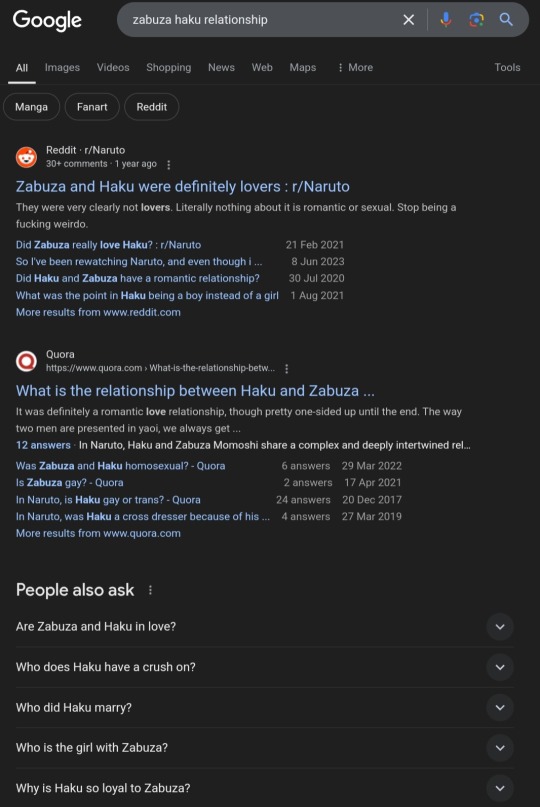
Kishimoto could have easily used a less controversial and more recognisable platonic relationship as the one that onsets the trajectory of Sasuke and Naruto's relationship, but he didn't.
Why?
Decide for yourself.
#sns#sasunaru#narusasu#is there an ongoing discussion about shounen being accidentally gay because of bakudeku?#ask#naruto
122 notes
·
View notes
Text






1. he is a pretty laid back dry goofy guy in cannon, i just cannot for the life of me see him as a full on dom but i don’t think he’s super subby either, he’s def in between imo
2. kisses fs!! im not a huge physical touch person but i like smoochin
3. he’s cool!! i wish we coulda seen his interactions more with panda yk? that scene of them bonding during the exchange even made my heart melt :( also really sad abt him bcs of miwa…. poor girl
4. probably!! i get fixated on doing certain things like that so ill try to do those again sometime :3
5. i like both but hair up gives early 2000’s and i live for it so i think i have a slight preference for that look
6. yes!! u can read the online copies weekly on shonen jump, and i buy the physical copies of any manga from anime stores :3
42 notes
·
View notes
Text
Kishimoto x Togashi Conversation ||| Second Fanbook Dec. 9th 2009
A conversation between shonen authors Masashi Kishimoto (Naruto) and Yoshihiro Togashi (HunterxHunter) that can be found on "Naruto Secret: Scroll of Everyone Official Fanbook" that came out on december 9th, 2009.

岸本齊史先生 x 富樫義博先生 二影 好談 無窮の高みをめざす 二つの影が交錯する!!
Masashi Kishimoto x Yoshihiro Togashi
Two-kage good talk/Two good stories (it's word play)
Aiming for infinite heights
Two shadows intersect!

『NARUTO-ナルト-』をはじめて読んだ冨樫先生の感想とは? 岸本: 冨樫先生お久しぶりです! 冨樫:こちらこそ、ご無沙汰していました。
What were Togashi-sensei's thoughts when he read "NARUTO" for the first time?
Kishimoto: It's been a while, Togashi-sensei! Togashi: It's been a while for me too.
---本日はよろしくお願いします!いろいろお話を伺っていきたいのですが、まずは先生の出会 いについて教えてください。
岸本:ほくはプロになる前から冨樫先生の大ファンで。 JF (※注1)会場などでご挨拶させていただいた時もすごくうれしかったんですが、数年先生とじっくりとお話させていただく機会が度だけあったんです。ぼくもよく知っているアシスタント(※注2)さんが先生の仕事場で働いて いたので、頼み込んでセッティングしてもらって。
冨樫:いっしょに焼肉行ったよね。
岸本:はい。ちょうどその頃、マンガを描くことの難しさに突き当たっていた時期で。色々アドバイスをもらおうと思ってたんですが、実際に会ったらすごく緊張してしまって・・・。 でも先生がとても気を使ってくださったので、ぼくも緊張が解けていろいろと質問できました。食事の後には仕事場まで見せていただいて。制作方法とか仕事場の雰囲気(※注3)の作り方とか、いろいろなことを勉強させてもらいました。
※注1 JF 1999年よりスタートした、週刊少年ジャンプ・Vジャンプ・ジャンプSQ (開始当時は月刊少年ジャンプ)主催による一大イベント。原作者の先生が登場 するステージも行われるため、 マンガ家同士が顔を合わせる貴重な機会ともなっている。
※注2 アシスタント マンガ制作作業を手伝う人達のこと。高い制作スピードが要求される週刊誌連載には、絶対に欠かせない存在である。 マンガ 家志望者が連載獲得までの間に行うことが多いが、マンガ制作補助を職業とする「プロアシ」と呼ばれる人達も存在する。
※注3 仕事場の雰囲気 冨樫先生がフランクにアシスタ ントさんと接する姿を見た岸本先生は、自分の仕事場でも同じような雰囲気を作ろうと決意。だが、最近ではフランクすぎて威厳がないのが悩みらしい。
---Thank you for joining us today! I'd like to talk to you about a few things, but first, please tell me about how you met.
Kishimoto I was a big fan of Mr. Togashi even before I became a professional. I was very happy when I had the opportunity to greet him at the JF (※Note 1) venue and other events, but over the years I only had a few opportunities to talk at length with him. An assistant (※Note 2) who I know well worked at Mr. [Togashi]'s workplace, so I asked him to set up a meeting for me.
Togashi: We went for yakiniku together.
Kishimoto: Yes. It was around that time that I was facing the difficulty of drawing manga. I wanted to get a lot of advice, but I was really nervous when I actually met him… But Togashi-sensei was very considerate, so I was able to relax and ask him a lot of questions. After the meal, he even showed me his workspace. I learned a lot of things, such as production methods and how to create a good workspace atmosphere (※Note 3).
※Note 1 JF Started in 1999, this is a major event sponsored by Weekly Shonen Jump, V Jump, and Jump SQ (originally Monthly Shonen Jump). Since there are stages where the original authors appear, it also provides a rare opportunity for manga artists to meet face-to-face.
※Note 2 Assistants People who assist with manga production tasks. They are absolutely essential for weekly magazine series that require high production speed. While aspiring manga artists often do this until they secure a series, there are also people known as "pro assistants" who make a profession out of manga production assistance.
※Note 3 Work Environment After seeing how frank Togashi-sensei is in his interactions with his assistants, Kishimoto-sensei is determined to create a similar atmosphere in his own workplace. It seems that recently, the overly casual atmosphere has been a concern for its lack of authority.
---冨樫先生は、実際にお会いするまで岸本先生の作品をご覧になったことはあったんですか?
---Mr. Togashi, had you ever seen Mr. Kishimoto's work before you actually met him?
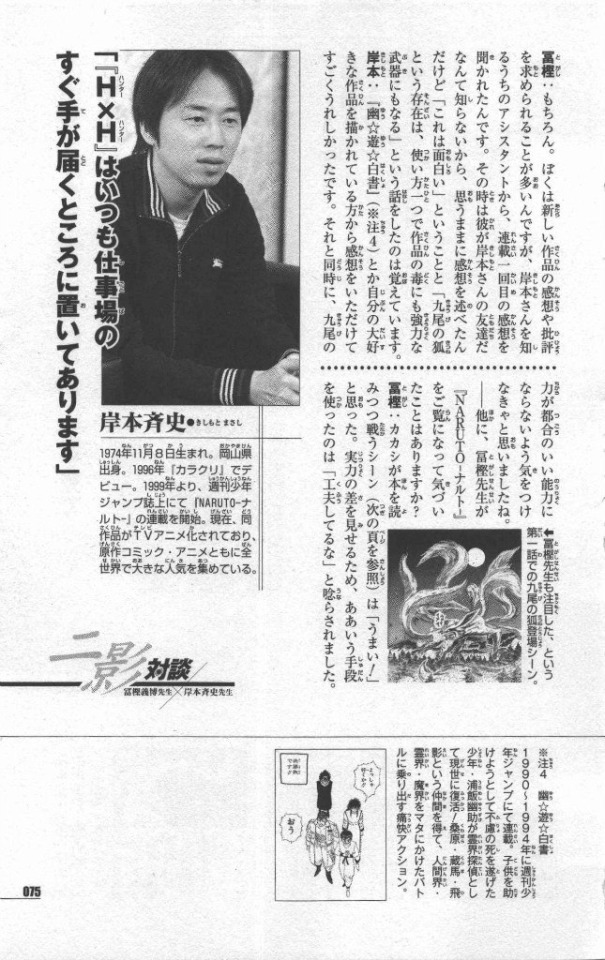
冨樫:もちろん。ぼくは新しい作品の感想や批評を求められることが多いんですが、岸本さんを知 るうちのアシスタントから、連載一回目の感想を聞かれたんです。その時は彼が岸本さんの友達だなんて知らないから、思うままに感想を述べたんだけど「これは面白い」ということと「九尾の狐という存在は、使い方一つで作品の毒にも強力な「武器にもなる」という話をしたのは覚えています。 岸本:「幽☆遊☆白書」(※注4)とか自分の大好 きな作品を描かれているから感想をいただけてすごくうれしかったです。それと同時に、九尾の力が都合のいい能力に ならないよう気をつけなきゃと思いましたね。
※注4 幽☆遊☆白書 1990~1994年に週刊少 ジャンプにて連載。 子供を助けようとして不慮の死を遂げた少年・浦飯幽助が霊界探偵とし て現世に復活!桑原・競馬・飛 という仲間を得て、人間界・ 霊界魔界をマタにかけたバト ルに乗り出す痛快アクション。
Togashi: Of course. I often get asked for my thoughts and critiques on new works, but one of my assistants who knows Kishimoto-san asked me for my impressions of the first chapter of his series. At that time, I didn't know he was a friend of Kishimoto-san, so I just expressed my thoughts freely. I remember saying that "this is interesting" and that "the existence of the nine-tailed fox can be a powerful 'weapon' or even a 'poison' for the work, depending on how it's used."
Kishimoto: "Yu Yu Hakusho" (※Note 4) and other works that I really love, so I was very happy to receive your feedback. At the same time, I thought I had to be careful not to make the power of the Nine-Tails too convenient of an ability.
※Note 4 Yu Yu Hakusho Serialized in Weekly Shonen Jump from 1990 to 1994. A young boy named Yusuke Urameshi who died unexpectedly while trying to save a child is resurrected in the present world as a spirit world detective! With the help of his companions Kuwabara, Keiba, and Tobi, he embarks on a thrilling action-packed battle that spans the human world, the spirit world, and the demon world. ---他に、冨樫先生が『NARUTO-ナルト-』をご覧になって気づいたことはありますか?
---Is there anything else that you noticed while watching "NARUTO", Togashi-sensei?
冨樫:カカシが本を読みつつ戦うシー��(次の頁を参照)は「うまい!」と思った。実力の差を見せるため、ああいう手段を使ったのは「工夫してるな」と唸らされました。
Togashi: I thought the scene where Kakashi fights while reading a book (see the next page) was "well done!" Using such a method to show the difference in skill made me think, "That's clever."

あと岸本さんは絵がすごくうまいよね。人の画力 を見る時は「人間の手をどれだけ描写できている 「か」を見ればいいと聞いたんだけど、物を持つ自然な感じとかがスゴいと思います。
岸本:ほく、体の一部を集中して描くのが好きで。学生時代はノートまるまる一冊に、いろんな角度から見た手や足を描き続けていたんです。ちょっとした手足フェチですね(笑)。
冨樫:あとは王道バトルものの定番要素と、岸本さんの独自性がいいバランスで組み合わさってると思います。
岸本: ありがとうございおます!最近では、最初に決めた設定のせいで物語作りに制約を感じることも多くなってきていて。いろいろ変えていきたい気持ちはあるんですが、なかなか難しいですね。
冨樫:自分の中で崩せないと思うルールを崩さなければ、どんな変化を加えても大丈夫。いろいろ挑戦してみてください。
※注5 HUNTER×HUNTER 1998年より週刊少年ジャンブにて連載。生き別れの父親ジンの後を追い、ハンター としての道を歩むゴンと、その仲間達の冒険を描いた本格アドベン チャーマンガ。
※注6 影分身 ナルトの得意忍術。自らのチャ クラを消費し、数多くの分身を 作り出す。分身は、攻撃だけでなく陽動や情報収集にも使える。
(Still Togashi): Also, Kishimoto-san is really good at drawing, isn't he? I heard that when judging someone's drawing skills, you should look at how well they can depict the human hand, and I think the natural way he holds objects is amazing.
Kishimoto: I really like focusing on drawing specific parts of the body. When I was in school, I used to fill an entire notebook with drawings of hands and feet from various angles. I guess you could say I have a bit of a hand and foot fetish (laughs).
Togashi: I also think there's a good balance of the standard elements of traditional battle stories and Kishimoto's originality.
Kishimoto: Thank you very much! Recently, I've been feeling more constrained in my storytelling because of the initial settings I decided on. I have a desire to change a lot of things, but it's quite difficult.
Togashi: As long as you stick to the rules that you think you can't break, it's okay to make any changes you want. Try out a variety of different things.
※Note 5 HUNTERXHUNTER Serialized in Weekly Shonen Jump since 1998. A full-scale adventure manga depicting the adventures of Gon, who follows in the footsteps of his long-lost father, Ging, and his companions as a hunter.
※Note 6 Shadow Clone Naruto signature ninjutsu. He consumes his own chakra to create numerous clones. The clones can be used not only for attack but also for diversion and information gathering.

岸本先生が『幽☆遊☆白書』『H×H』から受けた多大なる影響とは?!? ---さて今度は、岸本先生に冨樫先生が描く作品の魅力についてお聞きしたいと思います。
岸本:あらゆる面でスゴすぎますね。「幽遊」はプロになる前から読者として大好きでしたし、「HUNTER×HUNTER」(※注5)もすごく熱心に読んでたし。
---岸本先生が考える、冨樫先生の最もスゴい点はどこですか?
岸本: それ��ハッタリの見せ方ですね。まずは、主人公に立ちはだかる相手が強さを見せるシーンの作り方。ナルトの影分身(※注6)は「幽遊』の朱雀(※注7)がやる分身技にすごく影響を受けてますね。分身の全てが実体だという考え方が斬新だったし、「どうやったらこいつに勝てるんだろう ?』というワクワクをかき立てられました。 もう一つは、強さを見せるシーンでのセリフ使いや表情。ハッタリをかまされた主人公の微妙な表情バランスとか、すごく研究させてもらっています。連載当初、そういう表現法を勉強するための教科書が『HxH」だったんです。今でも仕事場の手が届く場所にあって、よく見返しています。あとは飛影(※注8)のキャラ造形がスゴいですね!
※注7 朱雀 霊界から人間へと逃亡してき犯罪者妖怪。自らの力を七つに分ける分身技・暗黒龍陣を駆使して幽助を苦しめた。
※注8 飛 かつて魔界で、盗賊として名を馳せた妖怪。額の部分に第三の 目邪眼を持つ。魔界の黒 炎を繰り出して相手を焼き尽くす邪王炎殺拳の使い手。
What is the immense influence that Kishimoto-sensei received from "Yu Yu Hakusho" and "H×H"?!?
---Now I'd like to ask Kishimoto-sensei about the appeal of the works that Togashi-sensei draws.
Kishimoto: He's amazing in every respect. I was a huge fan of "Yu-Yu" even before I became a professional, and I was also an avid reader of "HUNTER×HUNTER" (※Note 5).
---Kishimoto-sensei, what do you think is the most amazing thing about Togashi-sensei?
Kishimoto: That's about how to showcase a bluff. First, it's about how to create a scene where the opponent standing in the way of the protagonist shows their strength. Naruto's Shadow Clone Technique (※Note 6) was heavily influenced by the clone technique used by Suzaku in "Yu Yu Hakusho" (※Note 7). The idea that all the clones are real bodies was innovative, and it really sparked the excitement of "How on earth can we defeat this guy?" Another aspect is the use of dialogue and expressions in scenes that showcase strength. I've really studied the subtle balance of the protagonist's expressions when they are bluffed. Initially, "HxH" was the textbook I used to study such expressions. I still have it within reach at work, and I often revisit it. Also, the character design of Hiei (※Note 8) is amazing!
※Note 7 Suzaku A criminal youkai (mythological monster) who escaped from the spirit world to the human world. He used the Dark Dragon Formation, a clone technique that splits his power into seven parts, to torment Yusuke.
※Note 8 Hiei A youkai who once made a name for himself as a thief in the demon world. He possesses a third eye, the evil eye, on his forehead. He is a master of the Evil King Flame Killing Fist, which unleashes the black flames of the demon world to incinerate his opponents.

読者時代から飛影のファンだったんですが、自分が作品を描く時のキャラ作りで参考にさせていただいています。最初ぼくはクールな男性キャラを描くのがとても苦手で。自分の中にそういう部分がないから、どうやって描いたらいいのかわからなかったんです。そこで自分が大好きだった飛影を参考にして、サスケのキャラ作りを進めていき ました。写輪眼とか、必殺技のイメージとか、影響を受けた部分は結構ありますね。
---なるほど!そう言われるとうなずけます。
岸本: 作品に盛り込まれているアイディアの数々もスゴくて。各バトルにキッチリと勝つ理由とかネタが用意されているんです。ぼくが番好きな話は「H×H」でのゲンス ルー(※注9)と の戦いなんですが、あれもずいぶん前からラストへ向けてのフリが用意されてて。目にするたびスゴいなと思ってます。
※注9 ゲンスルー ハンター専用ゲーム「G」 に参加するプレイヤーの一人。他の参加者を大量に楽しクリア に近づくが、ゴンに敗北した。
※注10 映画 岸本先生も、無類の映画好き。 演出や物語作りを学ぶため映画館へ足を運ぶことが多いという。好きな映画のジャンルは、アクションだとか。
(still Kishimoto): I've been a fan of Hiei since my reader days, and I use him as a reference when creating characters for my own works. At first, I was really bad at drawing cool male characters. Since I didn't have that aspect within me, I didn't know how to draw them. So, I used Hiei, whom I loved, as a reference when creating Sasuke's character. There are quite a few parts that were influenced, like the Sharingan and the image of his special moves.
---I see! when you put it that way it makes sense.
Kishimoto: The ideas incorporated into the work are also amazing. There are solid plots and setups for winning each battle. My favorite story is the fight with Genthru in "H×H" (※Note 9) and even that had setups leading to the ending prepared long in advance. Every time I see it, I think it's incredible.
※Note 9 Genthru One of the players in the Hunter-only game "G". He defeats many of the other participants and comes close to clearing the game, but is defeated by Gon.
※Note 10 Movies Kishimoto-sensei is also an avid movie fan. He often goes to the cinema to learn about directing and storytelling. His favorite movie genre is action.

先生とは作品を通して会話してる 気がするんですよね
I feel like I'm having a conversation with the teacher through his work.
二人は似た者同士?? 共通する執筆スタイルとは? ---先ほどからお話を伺っていると、なんとなくお二人に共通するものを感じます。 冨樫:そうですね。ぼくは自分自身が物語に入り込み、全身全霊をかけて描くような熱いタイプの作家ではないんです。その代わりに映画 (※注10)や小説 (※注11)、他のマンガをすごく分析して、その面白い部分を自分なりに表現していくことは自 信がある。ぼくはマンガでメシを食って行こうと決めた時に、自分自身の好不調に関わらずいいモノを出していけるよう「技術だけで人を泣かせる話が作れるようになろう」と思ったんです。そのために、いろんな演出法や理論を勉強したり考え 続けていた時期があって。岸本さんにも似た感じ が見えるので、だいにシンパシーを感じています。
岸本:ほくも自分なりに分析をして三法(※注 12)とかそれぞれの方法に名前をつけて、���ート(※注13)に書いているんですよ!
※注11 小説 「幽☆遊☆白書」で登場した、領域」という言葉を使った特 殊能力が登場するエピソードは筒井康隆氏の小説にインスパイ アされてできあがったものだと冨樫先生は語る。
※注12 三択法 岸本先生が命名した、演出法の一つ。「AかB」という選択肢を提示したうえで、それとは別の選択・結末を見せることで読者に驚きを与える。
※注13 ノート マンガ家の作品制作に不可欠な道具。思いついた構想やアイデイアを描いて打ち合わせの場で見せたり、自分の考えを書いてまとめるために使われている。
Are they similar? What is their common writing style?
---As I've been listening to your stories so far, I somehow feel that you two have something in common.
Togashi: That's right. I'm not the type of passionate writer who immerses himself in the story and puts his whole heart and soul into it. Instead, I analyze movies (※Note 10), novels (※Note 11), and other manga thoroughly, and am confident in expressing the interesting parts in my own way. When I decided to make a living from manga, I thought, "I want to be able to create stories that make people cry using only my technique," so that I could produce good works regardless of my own ups and downs. To achieve this, there was a period when I studied and thought about various directing methods and theories. I see a similar feeling in Kishimoto-san, so I feel a lot of sympathy for him.
Kishimoto: I've also been analyzing things in my own way, naming each method like the Three Choice Method (※Note 12), and writing them down in my notebook (※Note 13)!
※Note 11 Novel Togashi says that the episode in "Yu Yu Hakusho" in which a special ability using the word "domain" appears was inspired by a Yasutaka Tsutsui's novel.
※Note 12 Three Choice Method A narrative technique coined by Kishimoto-sensei. The method presents the reader with two options, "A or B," and then surprises them by showing them a different choice or ending.
※Note 13 Notebook An indispensable tool for manga artists in their work creation. It is used to sketch out ideas and concepts and to present them during meetings, as well as to write and organize one's thoughts.

岸本先生の今後にとても期待しています!!
I have high hopes for what Kishimoto-sensei will do in the future!!
冨樫 あれは楽しいよねー。
岸本:ぼくも先生に似た匂いを感じているんです。ただ、分析だけだと熱い作家が持つノリの勢いは超えられないですよね。だからぼくも分析しながら最大限、物語に感情を込めて描いてるんですが先生の場合はその感情の部分というか、ドラマの部分もキッチリと描かれているのがスゴいと感じ ます。
冨樫: いや、岸本さんの作品も計算はされている けど、ここぞというところではしっかり読者の心を捉えられているんじゃないかな。ぼくも、その部分では苦労してきたから、作者の熱が読み手に届いてるのがよく わかるんだ。
岸本: ありがとうございます!ぼくにとって先生は、はるか高みにいる偉大な先輩であると同時に、WJという土俵で戦うライバルでもあって。お会いする機会はなかなかありませんが、いつも作品を通して会話してる気がするんですよね。
※注14 担当編集が同じ人 岸本先生の初代担当である矢作氏は、同時期 「HxH」も担当。憧れの作家に親近感を抱き喜ぶ岸本先生だったが冨樫先生を引き合いに出されヘコむことも多か ったとか。現在の二代目担当・ 氏も「NARUTO-ナルト-」と「HXH」の両作を担当中だ。
※注15 キメラアント編 自らに父の存在を知らせ、ハン ターへの道に導いてくれたカイ トとの再会を果たしたゴン。だが、彼との行動中に恐るべき生物・キメラアントと遭遇する。カイトの犠牲により脱出に成功したゴンとキルアは、彼を救うためハンター協会のネテロ会長をはじめとする強力な援軍とキメラ=アント殲滅へと向かう!
Togashi: That was fun, wasn't it?
Kishimoto: I also feel a similar vibe to yours. However, just analyzing it can't surpass the passionate momentum that a hot-blooded writer has, right? So, while I analyze, I try to infuse as much emotion into the story as possible, but I feel that in your case, the emotional part, or rather, the dramatic part, is depicted so precisely, which I find amazing.
Togashi: No, while Kishimoto's works are also calculated, I think they really capture the reader's heart at the crucial moments. I've struggled with that part too, so I can really feel the author's passion reaching the readers.
Kishimoto: Thank you very much! For me, you are a great senior who stands on a far higher level, and at the same time, a rival who fights on the same stage of WJ. Although we don't have many opportunities to meet, I always feel like I'm having a conversation with you through your works.
※Note 14 Same Editor Yahagi-sensei, who was Kishimoto-sensei's first editor, was also in charge of "HxH" at the same time. Although Kishimoto-sensei felt a sense of closeness and joy towards the admired author, he often felt down when Togashi-sensei was mentioned. The current second editor, Otsuki-san, is also in charge of both "NARUTO" and "HXH."
※Note 15 Chimera Ant Arc Gon reunites with Kite, who informed him of his father's existence and guided him on the path to becoming a Hunter. However, while on an adventure with him, they encounter a terrifying creature called the Chimera Ant. Gon and Killua manage to escape thanks to Kite's sacrifice, and in order to save him, they head out to annihilate the Chimera Ants with powerful reinforcements, including Chairman Netero of the Hunter Association!

冨樫先生に少しでも追いつけるよう がんばります!
I'll do my best to catch up with Togashi-sensei even a little!
お互いの未来に寄せるメッセージを披露!!
---それでは最後、互いにエールの交換をお願いします! 冨樫: 今の作品もすごく楽しく読ませていただいているんですが、この次にどんな作品を描くのかが、とても楽しみです。『NARUTO-ナルト-」のこれからと、岸本さんの今後にとても期待しています。
岸本: 担当編集が同じ人。(※注14)だったこともあり、プロになってからは憧れのほかに勝手な親近感を抱いてきたんですが、今日はしぶりにお会いできてすごくうれしかったです。『HXH』キメラアント編(※注15)の結末がどうなるのか一読者として、すごく楽しみにしています。これ からも、冨樫先生に少しでも追いつけるようがんばりますので、��ひぼくらの高い壁であり続けて ください!!!
冨樫:これから、マンガを描くのがもっと面白くなってくるはずだから。お互いに、がんばりましょう!
They shared their messages for each other's future!
---Well then, let's exchange cheers with each other for the last time!
Togashi: I'm really enjoying reading your current work, and I'm looking forward to seeing what you'll write next. I have high hopes for the future of Naruto and for Kishimoto-san.
Kishimoto: We have the same editor (※Note 14), I've felt a sense of closeness beyond just admiration since becoming a professional. I was very happy to meet you again today. As a reader, I'm really looking forward to seeing how the Chimera Ant arc of HXH (※Note 15) ends. I'll keep doing my best to catch up with Togashi-sensei, even if just a little, so please continue to be our high wall!!!
Togashi: From now on, drawing manga is sure to become even more fun. Let's both do our best!
10 notes
·
View notes
Text
I've been thinking about pacing.
Back when I was posting random thoughts about every new Shonen Jump title, I kept complaining about how they feel the need to cram everything into chapter 1. Premise, worldbuilding, main characters, some of the key supporting characters, primary antagonists, plot structure, tone, maybe a quick thesis statement. Everything gets a little time, nothing gets much development.
Contrast that with Oshi no Ko. The inciting incident is chapter 9. We get a whole chapter dedicated to the inciting incident, and we don't see it until we get eight chapters establishing our main characters and themes. We don't get the premise until the end of chapter 10. A whole volume of almost pure setup.
A slow pace, but OnK wouldn't work without it. Imagine if the 228 pages of volume 1 were compressed to the 50-ish that some Shonen Jump debuts get. Volume 1 is bookended by huge status quo changes—Dr. Amamiya's death and subsequent reincarnation, and Ai's murder and Aqua's revenge.
Realistically, we'd get maybe a dozen pages of Dr. Amamiya and his patients, maybe chapter 1 could end with Ai getting stabbed, and that leaves about 35 pages to tell the entire story of Aqua and Ruby's peaceful childhood. And that would be pretty slow by modern Shonen Jump standards; if we tried to squish Ai's death and Aqua's declaration of vengeance into chapter 1, so the reader knows what to expect and get excited about in chapter 2 (and maybe vote for OnK in the weekly popularity poll so the series doesn't get cut?), there would be less than half a chapter for the peaceful childhood.
Even if you cut Sarina and Ruby, that's not enough time to sell the reader on either Dr. Amamiya's life cut tragically short or the peaceful childhood Aqua lost when Ai was murdered. And for all my criticisms of how Ruby's character arc was wrapped up, OnK would not work without her. She's essential, and so is the time spent establishing the "normal world" before each of volume 1's status quo shifts.
You cannot tell Oshi no Ko under the constraints of a typical Shonen Jump debut. So it's a good thing Aka Akasaka wasn't working under those constraints! For starters, OnK is serialized in Young Jump, not Shonen Jump. More importantly, Akasaka got pretty famous from Kaguya-sama, so readers and editors alike are willing to give him the benefit of the doubt where they wouldn't for the mangaka of those new Jump series.
Shonen Jump puts its mangaka under a lot of pressure. If they succeed, they could become one of the most famous authors in the world, a small step below living legends like Eiichiro Oda. But if they fail—if volume 1 tankoban sales are weak or your weekly popularity poll results start to slump—they might find out they have got a month to wrap up their story before it leaves the magazine. And that includes the chapters they already submitted.
So you can't just tell a good story. You have to convince readers that you're going to tell a good story from chapter 1, you have to explain that story in the first 50 pages; you have to keep convincing readers that your story is worth reading, worth supporting, worth continuing.
You can't write Oshi no Ko under those constraints. In fact, I'm not sure you can tell any story.
I get the theory behind Jump's editorial practices. If you only let the strongest stories endure in your magazine, you'll have a handful of really strong stories plus a constant churn of new ones, good for both novelty and for increasing the odds that one of the new hopefuls will turn out to be one of those strong stories.
But that pressure forces authors to adapt or die, and the adaptations make the stories weaker. They constrain the stories in Jump to premises that can be fully explained in a handful of pages, squeezed between the handful of pages explaining their protagonist and the handful explaining the setting and so on and so forth. They also constrain how those relatively simple stories can be told, making it harder to build on those simple concepts.
And that's a problem Oshi no Ko didn't face. Say what you will about the back third or so, it had a really strong opening, specifically because of its slow pace.
16 notes
·
View notes
Text
akahika final thoughts (500 words + 1k supplementary content)
part 1
part 2
part 3 (you're here!)
Conclusion
It’s not mind-blowing to have some yuri or shojo influences in Weekly Shonen Jump magazine (or any shonen magazine). I mean, Blue Box is right there. What IS surprising, at least to me, is to see the Akahika rivalry take up so much narrative space. I love seeing girls who fight in a healthy way, and to have it take up space in the story rather than just a one-time thing is so satisfying to witness. I still can't believe the magazine that gave us Goku vs Vegeta, Naruto vs Sasuke, and Deku vs Kacchan now gives us Akane vs Hikaru (and Karashi. As a fun topping), and it feels completely natural with the rest of the Weekly Shonen Jump lineup. Similar to how shojo magazines have changed over time, we can see shonen magazines make changes by releasing a story like Akane-banashi. The fact an important rivalry for the shonen protagonist is informed by shojo and yuri story beats is just one of many ways Akane-banashi leads these changes.
I’ve wanted to make an essay about shojo rivalries for years, but if you had told me in the past that a shonen rivalry would inspire me to finally get it done, I would have told you, “be serious.” I have a love/hate relationship with shonen rivalries. I often find it dissatisfying when the protagonists rival is both most important to the protagonist’s story and most important to the protagonist’s personal life, but at the end, there’s this expectation that the protagonist still needs to adhere to social norms of what is actually supposed to be the most important part of your personal adult life, so now their rivalry can’t carry as much emotional weight as it once did. Honestly, it reminds me of Class S breakups because girls need to “grow up” into “real women.” Akahika, however, will never have that problem because while Hikaru is important to Akane’s STORY, she’s not the most important person in Akane’s life, nor is Akane the most important person in hers. This also means the emotional intensity of the Akahika dynamic is a bit more mellow than the average shonen protagonist rivalry, but I much rather have this so there’s room to watch Akane’s growth. I’m also a slow burn fan, so I could be biased.
In my biggest, most self-indulgent fantasies, Akane-banashi gets fully adapted into an anime and a live action film and Akahika becomes the next big shonen rivalry and the animated adaptation makes their homoerotic moments even more homoerotic and in the story conclusion Akahika run the Arakawa school together like how Issho and Shiguma do but better which basically makes them rakugo wives. Will any of that happen? Who knows! I don’t care. Akahika is already winning.
As a final note: Thank you so much for reading this! Even if you only made it through a portion of it, I hope it was informative. I know I learned a lot in the process of putting things together, at least. The discussion of shojo rivals is really underdeveloped in fandom, so I hoped this could spark your interest in them! My inbox is always for questions. I ask that you please consider skimming through the Supplementary Materials before sending a message, though.
Supplementary Materials
I’m using this section to include any extra commentary that didn't fit the main essay + educational materials that might be useful.
Educational Resources
I am far from an expert in shojo or yuri. There is a lot of nuance I did not cover because that was not the focus and I am not someone informed enough to discuss it. I barely feel like I'm informed enough to write this essay 😭. If you would like to learn more about the topics discussed (in English) from people who actually know about this stuff, I recommend reading essays like this one from a professor in manga + gender studies , this huge resource on yuri research, and the following blogs: okazu.yuricon.com, @/fehyesvintagemanga, @/osharenippon, @/retroyousei, @/brickme, @/yurimother and this article she wrote, @/empty-movement, @/animefeminist, @/ani-mentation, and also this paper on the early shojo decades. Oh, and this documentary on Takarazuka. And these interviews with a yuri author that inspired the "this too is yuri" meme.
Some commonly cited books are By Your Side: The First 100 Years of Yuri Anime and Manga which is by the host of the okazu.yuricon blog I mentioned in the paragraph above, and Boys Love Manga and Beyond: History, Culture, and Community in Japan. It might be more accessible to read an academic review of these books.
Bishonen/girl prince/boy prince aesthetics are informed by multiple different pop culture influences, not just the Takarazuka Revue. You can learn about one such influence here.
If you are interested in learning more about Takarazuka Revue, or watching a performance from a Takarazuka troupe, there is a fan wiki written in English for this very purpose.
If you don't watch Utena, you should at the very least watch Shiori's monologue since this was a big inspiration for part 2. You can also literally watch all of Utena eng sub/dub for free on Youtube (trigger warning list).
This isn't necessarily educational, but if you read all of this, you might be interested in this butch x butch yuri anthology.
Addressing Gaps in Analysis
I’m worried I threw around the term “sapphic subtext” a lot without clarifying what that exactly means.
The intention was to convey a distinction between "yuri" as a literary genre and "implicitly sapphic/lesbian relationships" overall, aka sapphic subtext. GL/yuri often has relationships that are almost entirely built on recognizable subtext because certain tropes get popularized. Often times, when I refer to "sapphic subtext," I am specifically referring to the subtext established by the yuri genre itself. However, because yuri also includes explicitly sapphic romantic/sexual relationships, it felt too confusing to just refer to everything remotely sapphic as "yuri." Hence, for the purposes of this essay, when I meant subtext, I said "subtext," and when I mean something explicitly sapphic, I said "yuri." Please know that these definitions are not concrete.
The full extent of the Takarazuka Revue's influence on how gender roles are represented and/or challenged in Japanese pop culture is complex. I want to clear up potential misunderstandings from my use of gendered terminology that may have come from this:
Do not confuse the Takarazuka-inspired girl-prince/girl-princess sapphic dichotomy described in this essay with a butch/femme dynamic. There is obviously overlap, but they are not synonymous with each other. A butch character is not always a bishonen character and vice versa. A femme character is not always a princess-like character and vice versa. I get these differences might seem miniscule, but when trying to do formal literary analysis, I think people should always be weary of applying Western terms to a culturally non-Western phenomenon, even if it usually communicates the same thing in a colloquial context.
"Are you familiar with the term akogare? So, in my research I did come across akogare (one of those nuanced "no direct english translation" words that seems to describe a deep admiration for someone??) to describe the sapphic subtext of retro shojo. Since I cannot with confidence explain what it means nor how the term is typically used, it wasn't mentioned in the analysis.
"Akane-banashi is a shonen manga and yet you barely acknowledged shonen manga history. What gives?" The answer is quite simple. The focus of this essay is not the shonen manga industry. I'm sure someone else would have a lot of fun analyzing Akahika in context of the history of shonen manga, the gender roles in shonen manga, or the impact of shonen manga on pop culture, but that person is not me.
“Why didn’t you talk more bout Glass Mask?” I never read/watched Glass Mask. While I was willing to read MANY things for this, I was not about to start the juggernaut that is Glass Mask just so I could include it in my analysis. I would love to see someone compare Glass Mask with Akane-banashi, though.
"What about Ruka?" This isn’t about him.
"What about Urara and Mayura?" This isn’t about them.
"I have misgivings about [interpretation of a complex aspect of RGU's narrative]?" Part 2 is catered to an audience who is familiar with Akahika, but not RGU, so some things like the rose bride/prince dynamic were dumbed down a bit. If you have RGU questions feel free to send an ask!!!
"Wait, why don't we talk about Act Age?" Short answer: I never read Act Age. Long answer: Act Age was a popular theatre manga published in Weekly Shonen Jump that was discontinued because the author was arrested for sexual harassment towards minors. Given Akane-banashi released approx 2.5 years later, it is possible that the former success of Act-Age influenced Akane-banashi's inception, but this is purely conjecture. I personally consider Act-Age defunct and irrelevant. I only mentioned it in the part 1 footnote because it used to be published in the same magazine as Akane-banashi.
9 notes
·
View notes
Text
Shoujo Manga's Golden Decade (Part 3)
Shoujo manga, comics for girls, played a pivotal role in shaping Japanese girls’ culture, and its dynamic evolution mirrors the prevailing trends and aspirations of the era. For many, this genre peaked in the 1970s. But why?
Part 1
Part 2
Follow the Trend
Before we move on to the third movement of the '70s, let's take a quick look at an essential characteristic of shoujo manga: its sensitivity to trends.
The early '70s were a confusing time for the industry. There was extreme freedom in certain corners, with Yukari Ichijo, Machiko Satonaka, and other prominent artists drawing very adult-like drama in shoujo magazines for very young girls. In contrast, there was also a lot of moralism. The fact manga wasn't taken very seriously meant magazines could get away with a lot since adults considered them terrible influences anyway. But, at the same time, since manga wasn't a respected medium, they were also prone to hysteria. Nothing illustrates this scenario better than the controversies surrounding "Harenchi Gakuen," the first full-length series by Go Nagai, who went on to become one of the most celebrated manga artists of the '70s.


Shameless! The nudity and erotic jokes in Go Nagai''s "Harenchi Gakuen" were a hit with kids and teens, scandalized parents and teachers, and made the shoujo industry chase after their own erotic hits.
Nagai, already a respected yet fledgling name in the industry, was recruited by Shueisha to be part of Shonen Jump's inaugural team in the late '60s. Jump, as any manga fan knows, is by far the biggest success story in manga's editorial history. However, back then, it was just a newcomer in a field dominated by Kodansha's Weekly Shonen Magazine and Shogakukan's Shonen Sunday. Go Nagai's series, whose translated name meant "Shameless High School," is Jump's initial smash hit and one of the titles behind its extraordinary ascent.
But "Harenchi Gakuen," a gag manga with erotic jokes, scandalized adults across the nation. The Japanese Parents and Teachers Association successfully led a Shonen Jump boycott, getting the magazine banned in several shops across the country and triggering a media circus. At the time, agitated journalists often accosted Go Nagai at airports and public events, aggressively pointing their mics at him, a consequence of manga-kas celebrity-like notoriety during that era.
Meanwhile, the reaction around "Harenchi Gakuen" did not intimidate other manga magazines. In fact, all of them were pursuing their own "harenchi"-like phenomenon and publishing stories with erotic dirty jokes. And yes, that included the manga magazines for little girls. In Ribon, male manga-ka Hikaru Yuzuki was responsible for the "dirty" manga series. At Weekly Margaret, Yuzuki also had a considerable hit with the high school comedy "Elite Kyousoukyoku," which, while not precisely "ecchi," had a tone reminiscent of Nagai's work. At Nakayoshi, the artist in charge of this type of content was none other than a pre-"Candy Candy" Yumiko Igarashi.
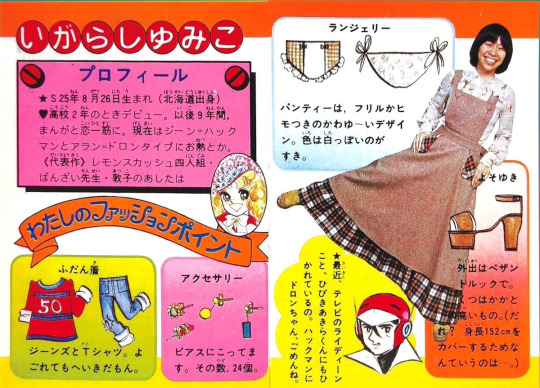
Before finding success with the smash hit "Candy Candy" manga, Yumiko Igarashi was the Nakayoshi artist in charge of recreating the "harenchi" phenomenon in the pages of the magazine. Above, in a good display of how public manga artists were in the '70s, Yumiko describes her panties as part of a Nakayoshi feature.
The "harenchi" phenomenon hinted at a shoujo field that wasn't yet wholly solidified and, therefore, was taking cues straight from the shonen segment, which would later become uncommon. But it also illustrates how the genre projects readers' dreams and preferences.
An example of this is one of Ribon's most popular series during the '70s, Yukko Yamamoto's "Miki to Apple Pie." Serialized between 1973 and 1976, this gag high school manga was full of absurd humor and nudity in the "Harenchi" vein. The twist is that it also had everything girls dreamed of.
The "apple pie" in the title was a reference to the lead character's favorite dessert during the time the American apple pie had just arrived in Japan and was considered the trendiest sweet. Miki Miyazawa, a popular and beautiful girl who served as the proxy for readers and was loosely modeled after talento Aki Aizawa, also loved astrology and the horoscope, and the romantic lead was a transfer student named Hideki Nanjo, who was a carbon copy of Hideki Saijo, the biggest popstar heartthrob of the '70s. Basically, "Miki to Apple Pie"'s central premise was "What if the popstars girls go crazy for was your silly gorgeous classmate?".
In fact, a testament to Saijo's popularity was how many shoujo manga romantic partners of the era used him as a model. Besides "Miki to Apple Pie," inserts of him were present in Satonaka Machiko's "Spotlight," Shigeko Maehara's "Kimi Iro no Hibi," Mayumi Yoshida's "Lemon Hakusho," among others.

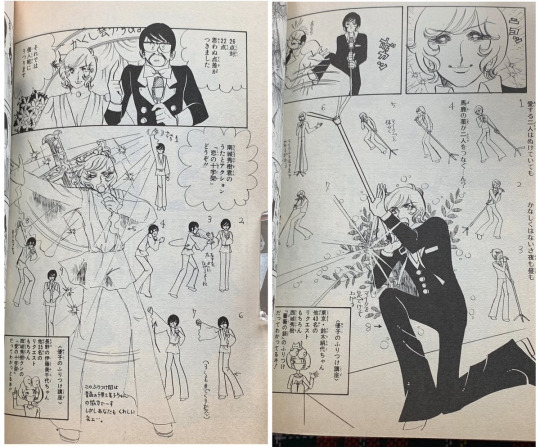
With nudity, slapstick humor, and numerous references to trends and pop culture, "Miki to Apple Pie" became a sensation in the pages of '70s Ribon. The romantic lead, Hideki Nanjo, modeled after heartthrob Hideki Saiji, frequently performed impromptu renditions of popular hits from stars like Agnes Chan, Finger Five, Momoe Yamaguchi, Junko Sakurada, and, of course, Hideki Saiji himself. Full of shockingly offensive and scatological jokes, very little was considered off-limits, making "Miki to Apple Pie" a quintessential example of the distinctive '70s shoujo manga published during the peak of the "Harenchi" boom. It also serves as a perfect time capsule of its era, satirizing and commenting on everything popular at the time—from iconic products like the Panasonic Quintrix television and memorable TV commercials to celebrities, the toilet paper shortage during the Oil Shock, the Discover Japan campaign, and the widespread teenage girls' fascination with horoscopes. This manga elevated shoujo manga's trend obsession to unprecedented heights and mixed it with absurdity.
Saijo is a relic of the past, but shoujo echoing the trends of its time is a timeless characteristic of the genre. That's why most shoujo artists are women who are close in age to their readers: this sensibility to girls' desires is a vital component of the market. From the way the characters look to how they dress to even the shape of their eyebrows, everything is supposed to reflect its time. Therefore, to successfully create shoujo, one has to understand how girls perceive themselves and also how they want to be perceived. How they dress and look, but also how and what they dream of looking and wearing. What they aspire to and, above all, what they find attractive in the opposite sex.
It was precisely that sensitivity and this unique sense of what girls want and dream of that led to the creation of what is now the number 1 shoujo manga trope: the high school romance starring an unassuming, ordinary heroine. Leading the way was another group of artists that, while not as internationally celebrated as the Year 24 Group, are definitely equally as crucial to shoujo history.
The Otometique Fervor

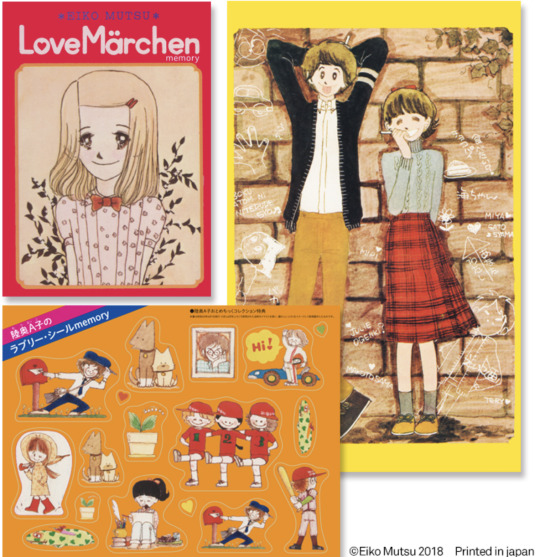
An "otometique" girl by Mutsu A-ko and some of the artist's popular furoku.
Yoshiko Nishitani, another of Shueisha's top shoujo artists of that era, is often credited as being the first to create a series around ordinary high school love. She did that in 1965's "Marie Lou," published in Weekly Margaret. "Marie Lou" was set in an American high school and had a very fashionable white girl as its lead. On her next manga, "Lemon to Sakuranbo" (Lemon and Cherries), she'd once again achieve immense success by bringing the teen romance closer to reality, using an ordinary Japanese high school as a backdrop.
While Nishitani pioneered this narrative style, the rise of more realistic, everyday stories gained momentum about a decade later. One catalyst for this was the "Otometique boom," a phenomenon that unfolded in the pages of Shueisha's Ribon magazine in the latter half of the '70s.
The term "Otometique" combines "otome," meaning "maiden" or a pure young girl, with the "-tique" (tikku in Japanese) suffix. A-ko Mutsu was the artist who spearheaded this movement.
A-ko made her debut in Ribon in 1971 at the age of 18. Her popularity skyrocketed four years later when her first short stories, led by "Tasogaredoki ni mitsuketa no" (What I Found at Twilight), were compiled into a tankobon that became a best-seller. This success elevated her status in Ribon, and soon her "otometique" style became the talk of the town.

Mutsu A-ko's art.
In contrast to the dramatic narratives of the "Satonaka-domain" faction, "otometique" stories adopted a more straightforward structure devoid of major plot twists and intense drama. Instead, they focused on modest love stories where the exhilarating moments were ordinary occurrences, like spotting a cute boy on the street or touching a crush's hand for the first time. While some stories included sad or supernatural elements, readers were captivated by the uncomplicated, heartwarming moments.
Ako's heroines were ordinary, unassuming schoolgirls, often characterized by shyness and insecurity. Different from extraordinary characters like Lady Oscar from "BeruBara" or the iconic Madame Butterfly tennis star in "Ace wo Nerae," Ako's protagonists were life-sized.
"Otometique" manga often incorporated romantic comedy tropes, such as chance encounters with cute guys on the way to school or the transformation into beauty after removing glasses. The happy endings typically featured a boy reciprocating the girl's love by accepting her as perfect and beautiful just as she was.

In otometique manga, girls were often in cute plaid and gingham check dresses and skirts, while boys were impeccably dressed in Ivy style, as seen in Mutsu Ako's art above.
While the stories may have seemed mundane, their distinctiveness lay in the meticulous attention to detail. As significant as the exploration of falling in love and discovering inner strength were all the visual details in "otometique" art. Girls had braids or long wavy hair and wore adorable clothes with plaids and gingham-check, as well as cute accessories. At a time when most Japanese girls still had Japanese-style rooms, "otometique" heroines had gorgeous Western-style rooms. They hung out in cozy cafes, made handmade goods, and ate tasty-looking sweets. Houses had French windows and balconies. Boys were tall, lean, with fluffy hair, and were always dressed impeccably in Ivy-style clothes. The "otometique" artists created an atmosphere that perfectly matched girls' aspirations at the time.
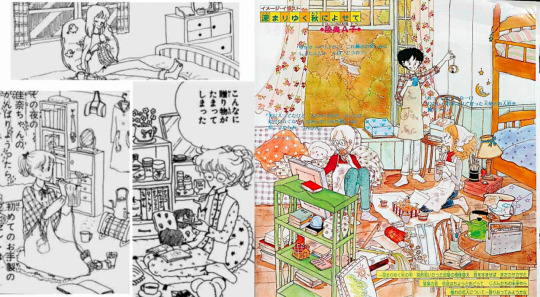
Girls often dreamed with having Western-style bedrooms like the ones in Otometique manga.
While Mutsu A-ko was the trailblazer, she was soon joined at the top by two other iconic artists, Yumiko Tabuchi, and Hideko Tachikake. Each of them had their quirks. Tabuchi, for example, often had college girls as her heroines, mirroring herself as a student at the elite, trendy Waseda University. While Tabuchi and A-ko preferred short stories, Tachikake had a penchant for longer series with a bit more drama. But they all had a similar aesthetic and relied on the charm of ordinary love.
The "otometique" phenomenon reflected the trends of the time and foreshadowed the emerging consumer culture that would swallow the country in the next decade. The sophisticated visuals attracted people of all ages, from elementary school-aged girls to highly educated women and men. Both the top public and private universities in Japan, Tokyo University and Waseda, respectively, had famous "otometique" clubs full of students who loved the genre and the style. The mangas were so trendy that they were often referred to as "Ivy mangas," in reference to the iconic Ivy style that was the catalyst of Japan's youth fashion, which was going through a second revival around that time.
While projecting an atmosphere that girls dreamed of, "otometique" also showcases '70s youth and girls' culture. Melancholic, simple love stories among young people were also the theme of the big folk hits of the time. Ivy or country fashion and long hair for men were the top fashion trends. Western-inspired ideals- in decoration, fashion, and musical taste- were pervasive. And creating subcultures and hobbies around consumption was the path society was taking. Simple life-sized stories as a narrative preference echoed the reality of Japan, which was stabilizing itself after decades of turbulence. These stories brought what the country was craving: comfort.

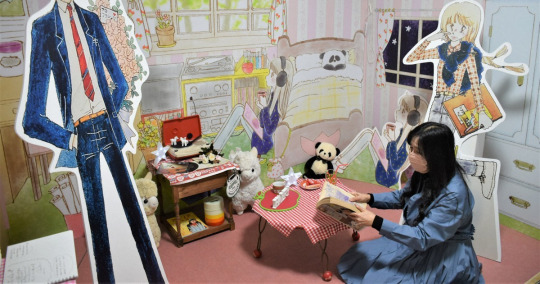
Above, a Mutsu A-ko's bedroom that lived in girls' imagination. Below, the room is recreated in a 2021 exhibition of Ako's art.
Meanwhile, the rise of consumer culture among young girls led to a "fancy goods" boom, with stores selling cute stationery, stickers, and small items popping up everywhere around the country. Illustrators and companies, eager to capitalize, spared no time in creating appealing mascots and drawings to adorn these goods, and it was in that period that Sanrio created Hello Kitty.
Ribon and Nakayoshi, which were "furoku" magazines, also benefitted. Furoku are extra gifts that come with the purchase of the magazines. And the "otometique" boom meant Ribon could include "fancy goods" -- like notebooks, stickers, letter sets, and small paper goods readers could assemble -- with the illustration of these highly sought-after artists. Most girls around Japan could only dream of Western-style rooms, a closet full of cute Ivy fashion, trips to trendy cafes, and homes with French windows. But they could recreate a bit of this sophisticated atmosphere by having letter sets, notebooks, stickers, and small accessories with A-ko Mutsu, Hideko Tachikake, and Yumiko Tabuchi's art. These popular furokus and the "otometique" stories were critical for Ribon magazine to surpass 1 million copies in circulation.
Girls admired A-ko, Tabuchi, and Tachikake not only as artists creating heartfelt stories with attractive atmospheres but as personalities. The trio, who were in their late teens and early 20s, closely resonated with their fans due to their proximity in age and shared interests. The readers were moved when Ribon featured an article in which A-ko Mutsu had the opportunity to meet and interview her favorite singer, the rock star Kenji Sawada, a prominent teen idol of that era. The positive response was so overwhelming that, a few issues later, Hideko Tachikake, an avid folk music enthusiast, also had the chance to interview her idol, Kosetsu Minami, the lead singer of Kaguyahime.
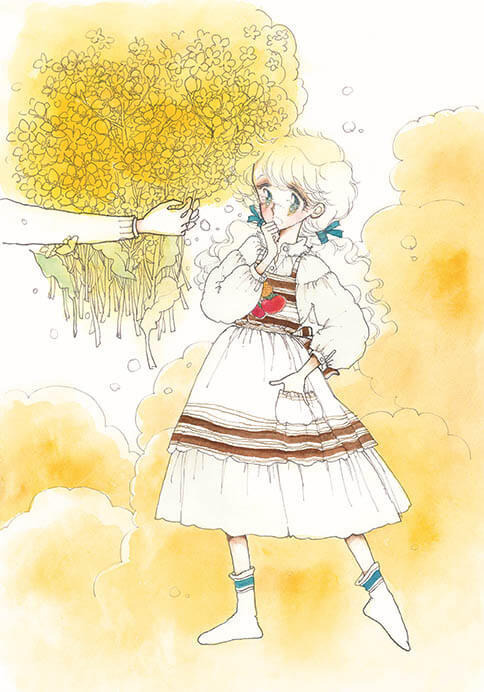
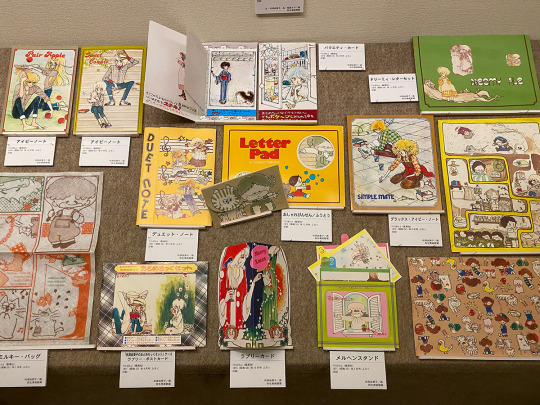
An otometique girl by Yumiko Tabuchi (left) and a collection of furoku illustrated by her as seen on a 2021 exhibition on her art.
The popularity of "otometique" peaked in 1977. By 1981, the boom had almost faded, and A-ko, Tabuchi, and Tachikake published their last works on Ribon in 1985. Tabuchi and Tachikake married and semi-retired, while A-ko successfully transitioned to manga for adult women.
Despite the end of the style, "otometique" permeated every corner of Japanese society. Its furoku and atmosphere were one of the bases for the almighty "kawaii" culture which now rules the country. The life-sized heroines and focus on mundane love stories and everyday emotions went on to become one of the main characteristics of the shoujo manga industry.
The Iwadate Domain
For years, the influence of "otometique" has been downplayed, one of the reasons why the movement is almost undiscussed in the West. However, in the last few years, best-selling books reminiscing the style were published, and exhibitions of A-ko Mutsu and Yumiko Tabuchi's works were big hits across Japan. A-ko, who moved back from Tokyo to her hometown in Fukuoka and never stopped creating manga, was recognized by the local prefecture as an honorary citizen and gained a permanent museum in the area, signaling her importance to the industry.
But while the "otometique" phenomenon happened on the pages of Ribon magazine, Mutsu, Tabuchi, and Tachikake weren't the only three attracting a massive audience to this type of real-life love story.

Mariko Iwadate's work was extremely popular from the late '70s to the mid-2000s. Above, a collection of her work from her Margaret era.
Going back to the research of sociologist Shinji Miyadai, three domains divided '70s shoujo. There was the "Moto Hagio domain," which included the Year 24 artists. The Hagio domain was more highbrow and intellectually challenging, and many considered it an equivalent to literature, attracting the intellectual elite that sniffed at manga in general. It is by far the most discussed and debated '70s shoujo movement, as well as the most famous in the West, but it was the least commercially successful at the time. Then there was the "Machiko Satonaka domain," with emotionally driven stories full of drama, plot twists, and larger-than-life heroines. Most of the '70s best-selling shoujo series fall under this category, which includes the work of Yukari Ichijo and Ryoko Ikeda and sports manga like "Ace wo Nerae," among others.
Finally, there's the domain in which the "otometique" stories were created. And Miyadai doesn't name it after any of the Ribon artists, calling it the "Mariko Iwadate domain" instead.
In the Satonaka domain, the heroine served as a proxy for the reader in a fantastical world, while in the Iwadate domain, the heroine represented the reader in the real world. But, after all, who is the influential Iwadate?
Mariko Iwadate, who made her debut in 1973 at the age of 16, rose to prominence by embracing the "otometique" style during its peak in the late '70s. Similar to Ribon artists, Iwadate, who mostly worked for Weekly Margaret, captivated readers with her elegant and stylish art, featuring cute clothes, accessories, and intricate details.
Miyadai's choice to name the category after Iwadate rather than the genre pioneer A-ko Mutsu may be attributed to Iwadate's sustained success. After leaving Ribon in 1985, A-ko remained prolific and had a dedicated audience, but she couldn't replicate her peak. Iwadate's popularity, on the other hand, continued unabated even after she transitioned to adult women's manga. Iwadate's work, recognized for its emotional depth, became a significant inspiration for trailblazers like best-selling novelist Banana Yoshimoto and avant-garde manga artist Kyoko Okazaki. In 1993, when Miyadai wrote his book, Iwadate's fame and respect probably made her a more recognizable figure for readers to associate with the category.

Iwadate's soft girly art and story-telling made her extremely popular and influential.
Mariko Iwadate's narrative, especially her post-80s work, has a more psychological and mature element to it when compared to Ribon's artists. She, as an artist, bridged the gap between "otometique" and another highly influential "Iwadate domain" artist, Fusako Kuramochi.
Fusako Kuramochi, debuting while still a teen in the early '70s at Bessatsu Margaret (Betsuma), initially emulated her favorite artists, Moto Hagio and Keiko Takemiya, before finding her style—a realistic portrayal of romance with a substantial psychological element. Her success contributed to shaping Betsuma, alongside Ribon, as arguably the most influential and commercially thriving shoujo title -- the go-to magazine for high school rom-com.
Like the otometique artists, Fusako Kuramochi first gained prominence with short stories and one-shots. In 1979, she wrote her first series, "Oshiaberi Kaidan," in which each chapter depicted the life of a young girl from junior high to her graduation day. In 1980, she published "Itsumo poketto ni Chopin," a classical music manga that also dealt with growing up as a teenager in the city. From then on, she'd publish about two hit series every year in Betsuma before graduating successfully to adult women's manga in 1994.
Kuramochi's success was due to her great skill in portraying girls going through crushes, heartbreaks, and jealousy. The psychological elements struck a chord with readers and helped her create male romantic leads that were extremely popular.
Another component of Kuramochi's work was her sophistication, a result of her upbringing. Her father was the chairman of one of Japan's biggest printing companies, and she was raised in Shibuya, in the center of Tokyo, while attending an exclusive all-female institution. The fact she spent her youth in the middle of Tokyo's hustle and bustle meant she knew the capital well, and her works were full of references to trendy cafes, restaurants, nightspots, and neighborhoods. Her Betsuma work was published right before and during Japan's ostentatious Bubble years, so many chasing an exciting city life referred to her work.
While her stories reflected the reality and aspirations of the Bubble years, Kuramochi's true gift lay in providing readers with a realistic depiction of growing up and falling in love, making her work immensely popular. In general, consumerism -- displayed through clothes, accessories, and decor -- isn't as crucial to her success as the three Ribon "otometique" artists.
While Fusako Kuramochi is part of the "Iwadate domain," you can argue that Kuramochi evolved into her own category, which was vital for the development of real-life love stories in shoujo in the '80s and '90s and the rise of other highly-influential artists like Ryo Ikuemi.
But going back to the three '70s movements, "otometique"/"Iwadate domain" was definitely the most influential one in steering shoujo manga in its current direction. On the other hand, all of these domains co-existed together and fed from each other. In 1977, during the "otometique" boom, Yukari Ichijo remained untouched as one of Ribon's most popular artists with her emotionally charged dramas. It was the success of Ichijo and other "Satonaka domain" artists that allowed the "Hagio domain" to debut and take risks. In turn, it was the "Hagio domain" that showed there were rewards for young risk-taking shoujo artists.
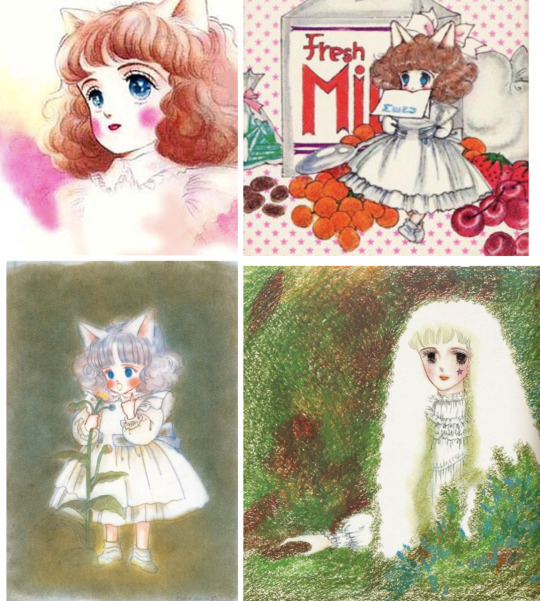
Yumiko Oshima, known for her girly art and sensitive story-telling, is the inspiration behind the otometique boom.
When asked which artist inspired them the most, both A-ko Mutsu and Mariko Iwadate gave the same answer: Yumiko Oshima. Oshima, known for her quirky love stories and girly art, is an artist who trained alongside Hagio and Takemiya at the Oizumi salon and rose as part of the "Year 24 group," publishing risk-taking manga in Shogakukan and Hakusensha's magazine after a brief stint in Weekly Margaret. In other words, despite the striking differences, the origin of the "Iwadate domain" is the "Hagio domain."
While the influence of the idealized real-life romance is the one we can better observe today, contemporary shoujo would not exist if not for all these three styles meshing together and creating something new. And from that, things kept evolving and changing and gaining new forms. Because, once again, manga, and especially shoujo manga, is about reflecting the girly ideals of its time.
#ribon#margaret#go nagai#miki to apple pie#yumiko tabuchi#otometique#otometique manga#mutsu a-ko#mutsu ako#hideko tabuchi#70s japan#fusako kuramochi#betsuma#shoujo manga#vintage shoujo#vintage manga#harenchi gakuen#yumiko igarashi#nakayoshi#yumiko oshima
50 notes
·
View notes
Text

Ohh, I also recently got this acryllic stand featuring this Fairy Tale (Red Riding Hood and the Wolf) version of Undead Unluck's Andy and Izumo Fuuko!
This is actually from a Weekly Shonen Jump blindbag acryllic stands collection that featured the cover illustrations from Weekly Shonen Jump 21-22 (2021), which was released... last year, I think? This collection is based on, you guessed it, fairy tales. You had, for example, Luffy dressed as Aladdin, Roboco as Snow White, etc, etc. These were also released in "mini" variants, but I suppose those were lottery or subscriptions related...? And are much smaller than these.
ANYWAY, I basically fell in love with this one. Especially since these are the same outfits or versions of Andy and Fuuko that were featured in Ch 39's color cover (which, instead, happens to be one of my fave color covers of the series so far...) and MAN, do I love a nice werewolf design (and it fits Andy SO WELL, I CAN'T-) And Fuuko as Red Riding Hood is nice.
That being said, GOSH, I WISH there were WSJ-related stuff like these AGES ago! There's neat older thematic cover illustrations variants from WSJ featuring their older series and I feel they would have looked SO cool in physical merch like this? Especially when I am more familiar with some of their older series that have finished in the past few years :').
Here it is with my other couple of acryllic stands of Mage (I wish he had more meat on his bones, but this was from those CG profiles from the Dandevi PSVita game) and MeiRitsu (this one actually featuring art by @/kuroztonbi)
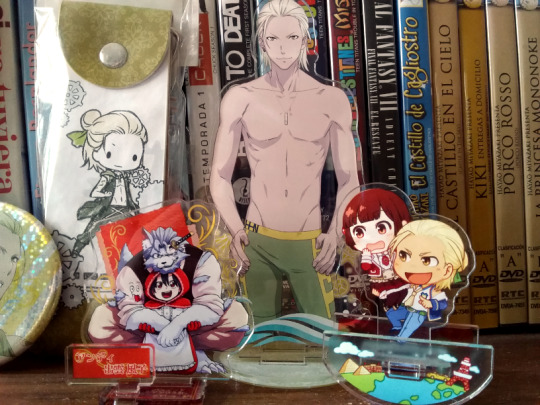
#undead unluck#yoshifumi tozuka#weekly shonen jump#my collections#my recent purchasing hauls#Clothey is also here and I... simply love they are eating Fuuko's hood lmao#the concept of a version of Andy that is a werewolf is *eyes emoji*#werewolf#werewolves
39 notes
·
View notes
Text


Today’s drawing, A dvorkk grone inspired Klonoa based on this illustration of Josuke from Weekly Shonen Jump 1992 Issue #24!
Here’s their twitter: https://x.com/dvj000000?s=11
#art#my art#traditional art#traditional drawing#traditional illustration#klonoa fanart#kaze no klonoa#klonoa#ジョジョの奇妙な冒険#風のクロノア#クロノア#fan art#fanart#josuke higashikata#jojo fanart#jojo's bizarre adventure#diamond is unbreakable#diamond is not crash#jojo part 4
12 notes
·
View notes
Text
104th Hop Step Award - H☆S (October, 1993)
Togashi-sensei's Direct Instructions! The road to conquer all areas of manga!
Mass Recruitment for the 104th (October 1993 Term) H☆S Award!! This month's judge is Yoshihiro Togashi-sensei!

The Hop☆Step Award (H☆S Award) was a monthly recruitment project by Weekly Shonen Jump (Shueisha) that took place from March 1985 to July 1996.
I already translated Togashi's ten "4-koma" that he drew during the Yu Yu Hakusho serialization to give advice to the participants of the H☆S Award - October 1991 & 1992 Terms.
This time, I am translating the October 1993 Term, where he gives the newcomer manga artists more tips and advice on how to create different styes of manga. The winner of this edition was Eiichiro Oda with the one-shot "Ikki Yakō" (一鬼夜行). At the time, Yu Yu Hakusho was in the Black Chapter Arc.
Togashi gives instructions to help creating gag, love comedies, sports and fantasy manga. He used a little bit of all those elements in Yu Yu Hakusho.
Part 1. Gag Manga
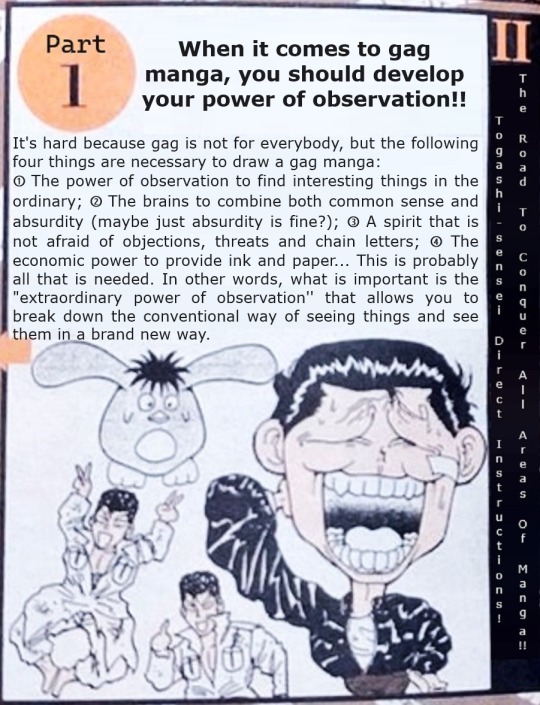
T/N: Chain letters (letters of misfortune) were popular in Japan during the Showa era. A ''letter'' or ''postcard'' was delivered to your home/work in the style of ''If you do not send it to a certain number of people, you will be unhappy.'' The sender is unknown. Chain letters were also a hot topic in magazines and manga, like Doraemon and a bunch of gag manga.

Source: Weekly Shounen Jump N°44, 1993. Shared by katsura_00
The funny versions of Yanagizawa, Kido and Kaito represent the editors in charge of:
Jungle King Tar-chan/DNA² (Kaoru Kushima);
Lucky Man/JoJo (KAITO Katsuhiko);
Yu Yu Hakusho/Monmonmon (Tomoyuki Shima)
Waiting for powerful works that will break these guys territories! !

They were responsible for the screening, checking all the applications and eliminating the mediocre works before passing them on to Togashi. Inside their territories, works with "characters that are all very similar," "characters with no strong personality at all" or "just imitations of existing characters" were mercifully discarded.
Part 2. Romantic Comedy


Source: Weekly Shounen Jump N°45, 1993. Shared by katsura_00
Part 3. Sports Manga

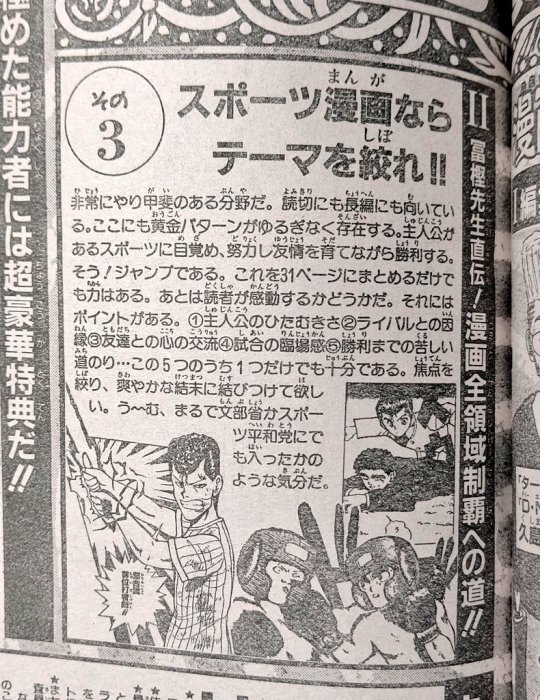
Source: Weekly Shounen Jump N°46, 1993. Shared by katsura_00
Part 4. Fantasy Manga
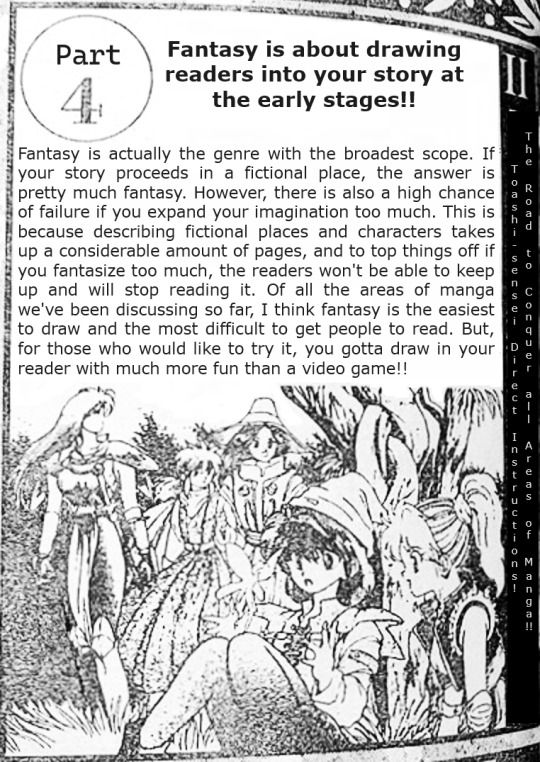
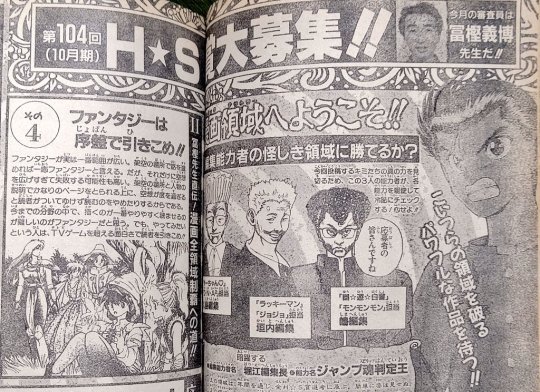
Source: Weekly Shounen Jump N°47, 1993. Shared by katsura_00
T/N: The fantasy illustration of Botan, Keiko, Yukina, Shizuru and Atsuko in medieval clothes was designed to the opening page of Yu Yu Hakusho volume 11, tankobon edition.
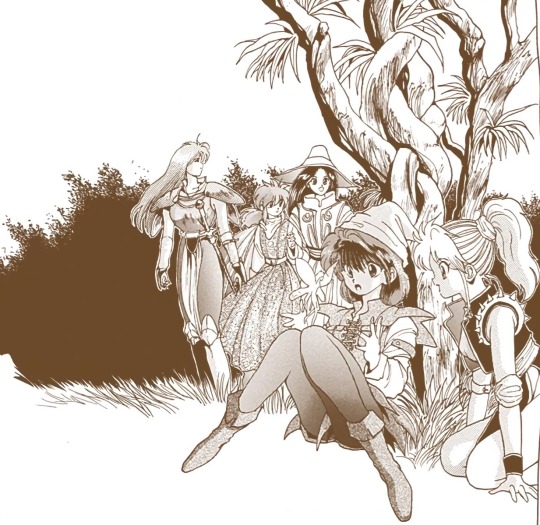
🏆 Winner: Eiichiro Oda
Oda-sensei was the inner of this edition! Togashi-sensei reviews his 31-page one-shot, "Ikki Yakou", that was published in the 1994 Shonen Jump Spring Special, and later reprinted in 1998 as part of Wanted!, a compilation of Oda's pre-One Piece stories.
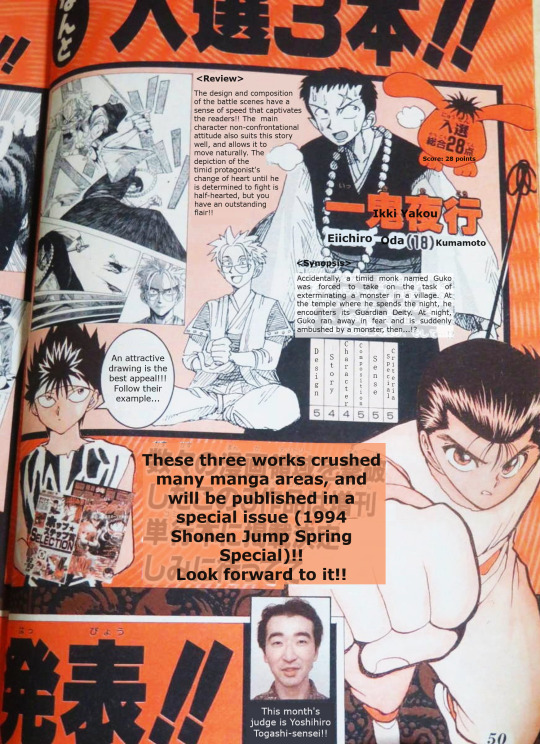
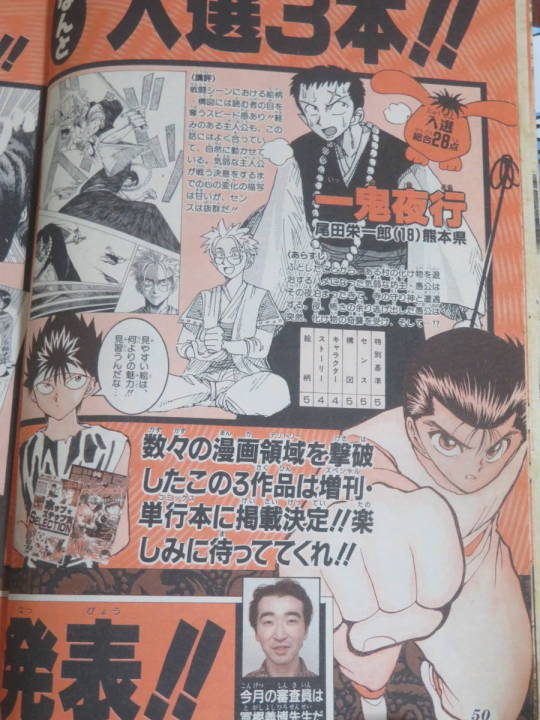
Source: Weekly Shounen Jump N°2, 1994
#Yoshihiro Togashi#Yu Yu Hakusho#hop step award#Weekly Shounen Jump#1993#H☆S Award#gag manga#romantic comedy#Eiichiro Oda#sports manga#Togashi's advice#一鬼夜行#Night Parade of One Demon#fantasy manga
31 notes
·
View notes
Note
There is a thread on Twitter about how Weekly Shonen Jump handles the ending of a popular series.
https://x.com/Cer_clover/status/1822057976783351845?t=yksiQQWNq-X2g7gAxjaaoA&s=19
JJK is unlikely to get a 2nd part because of how Weekly Shonen Jump handles endings. Once a series enters its final arc, the mangaka and editors set a deadline for how many chapters are left. This deadline rarely changes, which means the story often gets rushed, with skipped plot points and condensed character arcs.
The length of a manga series is often decided through discussions between the mangaka and their editor. The editor needs an idea of how long the series will take to finish, which leads to talks about whether the story should be extended or shortened to fit the magazine's schedule.
Creating manga for a magazine is still a job, and not every artist gets the same flexibility as big names like Oda (One Piece) or Araki (JoJo's Bizarre Adventure). Most artists have to adapt to these restrictions and do their best to finish the series within the given timeframe, knowing they may not get another chance if they miss the mark.
Shonen Jump doesn’t usually give extra time after setting a final chapter number. Even if JJK got a second part, it would still face tight deadlines, leading to the same rushed feeling we’ve seen in other series. It’s better to end JJK in its current run, allowing the story to finish naturally without the pressure of a second part that might feel incomplete.
We've seen this happen with other long-running series like Bleach and My Hero Academia, where the endings felt rushed and left fans disappointed. Since JJK already has many characters, subplots, and a complex world, stretching it into a second part would likely make the problem worse.
This makes me believe that despite the series popularity, it's unlikely that the magazine would move from their hard deadline.
I'm not saying that WSJ would do anything with their deadline. My thoughts since the end has been anounced, are that the JJK manga would wrap up and some time later, probably several months and maybe even in 2025, a new JJK series would be anounced when the magazine has the correct time slots again and Gege had a vacation in Europe or something.
I also don't see the story as stretching into a second part, with how JJK has been told, it would be about telling the parts that are already there and finishing them in a new and less stressful environment because I can imagine a fresh start with a new chapter 1 to be exactly that.
It's like how Naruto had Boruto as a sequel but this time it wouldn't be done with a finished story carrying over to the next generation (because even if JJK completely ends now, there is so much left undone that I will not call it a well rounded story). It would be like: timeskip, old story beats that were left open interwoven with new themes and maybe even a protagonist and genre change.
But we'll see. We'll see.
Until then though I don't want to stop theorizing and analyzing the story and the circumstances that are presented to us. Like, why would I not want to make posts about how we could get JJK 2: More Kaisening?
Am I supposed to be afraid of being wrong about it or something like that? 😂😂😂😂 I don't know about anyone else out there but I'm enjoying myself right now and I hope others are too :D
2 notes
·
View notes
Text
The news that PPPPPP is being canceled with the upcoming chapter is just devastating. The series was so good and it deserved way more than a rushed non-ending like this. Mapollo3's art and storytelling was far above the level Jump typically gets. Honestly the series was too good for the magazine and I hope that Mapollo3 will find another publication that appreciates his talents more than Weekly Shonen Jump did. I'm not ready to say goodbye to these characters yet. Fire Nakano
#pppppp#weekly shonen jump#mapollo3#fuck this#i hope the battle losers are happy with whatever new series replaces it and immediately gets axed like the last seven
34 notes
·
View notes
Text
Hearing that PPPPPP has been cancelled is making me feel so sad and so angry. It's not the first time Jump axed one of my faves (RIP Mitama, Magu-chan, Agravity boys...) But this one really stings.
PPPPPP was a real gem among the current lineup-- unconventional and with so much potential. Of course an introspective story about classical music was never going to be the number one series in the home of the battle manga. But it took some other Jump staples as a starting point (the school setting, the mediocre main character persevering through effort, friendship and (piano) battles) and turned it on its head-- using beautiful silent panelling to convey sound! And convey complex emotions! Gently twisting reality and portraying devastating loss by making chapters 61-64 feel off and dreamlike. Losing competitions but winning the bigger fight: helping his siblings one by one by showing them kindness and love. A manga you'd expect in a magazine like Harta, or published alongside Totsukuni no Shoujo.. but read by thousands in Shonen Jump!
Yes they took a risk but you'd think that PPPPPP did enough to prove its value in Jump during its 70 chapter run: Despite not scoring high in weekly rankings, the volumes sold well (350.000 for 7 volumes in one year is not bad!!), it's been recommended by other mangaka (including Shiro Usazaki, artist of Act-Age), it ended up on a few lists of manga to watch out for (THIS MONTH placed #10 in the Nationwide Bookstore Employees' Recommended Comics of 2023). It was by no means an unpopular or bad manga! It did not deserve to be cancelled like this. It's not even moving magazines or to Jump+. Not getting a long epilogue chapter in Giga or online. Not getting extra chapters in the final volume. Just an axe.
This story deserved a proper ending. No way Lucky is getting his catharsis in one 24 page chapter. No way are we going to gain insight into Gakuon's mind. We won't get proper reconciliation between the siblings. Find out how Don and Shikato played the piano, their relationship with Lucky. Or see what happens to Lucky's friends who have been deciding on their own futures.
I can only commend Mapollo 3 for still giving us so much in those last few chapters. I don't know how much notice he was given before the axe, but I am thankful that we got to meet Don and Shikato and got Dada's flashback. Shikato's creepy, dissolving smile and the "average Gakuon fantasy" two page spread will be seared into my brain for a whille.
For us readers, for a few days more, Lucky is still lying in that graveyard with Gakuon gazing silently at his unconscious body. It seems like a cruel, poetic coincidence that actually feels fitting for this manga. I hope chapter 70 takes us back there, so we can say goodbye to Lucky, and Mapollo 3's quietly captivating story.
#pppppp#i was so angry i rage-infodumped the entire jjk manga at my brother (he's anime only but didn't mind me spoiling) and calmed down#but still wrote more than i thought i would#i'm probably not done...#well. one chapter left. let's hope its a good one#mmnmmq.txt
43 notes
·
View notes
Text
Jaco the Galactic Patrolman Ch.1-5
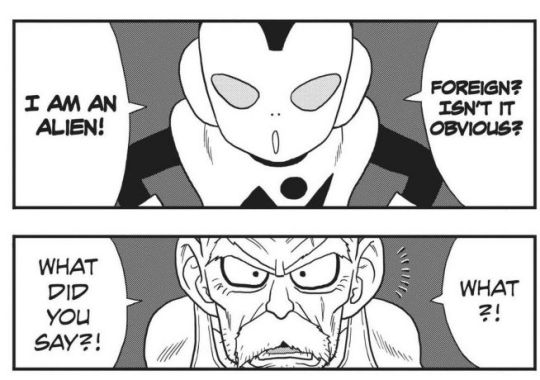
After the premiere of Battle of Gods, and the crossover appearance of DBZ characters in Toriko and One Piece, Akira Toriyama published a new manga, entitled Jaco the Galactic Patrolman. The series ran in Weekly Shonen Jump from July to October 2013.
It’s weird, because 2013 wasn’t even that long ago, but it feels like a different era to me, at least in terms of how I consumed anime and manga. At the time, I was interested in the new Jaco series, but I was also resigned to the fact that it would be years before I could read it. As it was, I managed to snag a fansub of the Battle of Gods movie around that time, as the DVD was released in Japan in late ‘13, but the movie wouldn’t reach the U.S. until the following year.
Since then, new Dragon Ball movies have premiered in the U.S. within months of the Japanese release, and the delay seems to get shorter each time. A lot of new anime, including Dragon Ball Super, has been simulcast on Japanese television and Crunchyroll.
Also, scanlations for new manga seem to be a lot easier to find than they used to be. I read all of Jojolion through a website dedicated to providing translations of current manga titles, and the only reason I’m not reading JoJoLands right now is because I wanted to wait a while and let a few chapters build up before I start.
The idea that I would have to wait for a proper English language version of a new release had become so alien to me that it seemed genuinely frustrating that Stone Ocean was exclusive to Netflix, and we all had to wait for episodes to be debuted in batches across 2022. But back in the early 2000′s, that’s how it was for everything.
Anyway, I wasn’t too concerned with Jaco as a character, but then he showed up in Resurrection F, and like, a bunch of episode of Dragon Ball Super, so I kind of felt like I had missed out on something. But I never felt too motivated to sit down and read this thing, even after it became available in English. But that’s what the 2023 Dragon Ball Apocrypha Liveblog is for, folks. I made a list of all the stuff I hadn’t gotten around to checking out, and now I’m finally getting to it.

Chapter 1. Jaco is on his way to Earth for a mission, when he accidentally collides with the moon and damages his ship. He crashes in the ocean, and has to carry his ship ashore onto an island. There, he meets the island’s sole inhabitant, Professor Tokunoshin Omori, who gives him food and shelter while he tries to repair Jaco’s ship.
Over the course of the story, Jaco tosses out tidbits of outer space lore. For example, he knows all about Earth because the Galactic Patrol has sent robots disguised as insects to gather information. Jaco learned all Earth languages thanks to a technology that uploads the information into his brain. Why doesn’t he possess the knowledge to fix his own spaceship? Because he skipped that lesson.
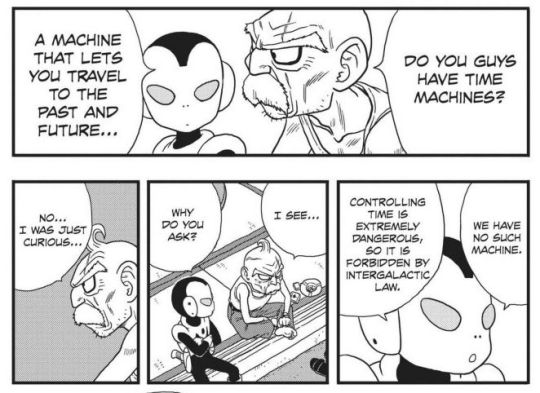
Omori is a scientist, and back in the day the island was a government research facility working on developing a time machine. Then one day there was a terrible accident which killed Omori’s wife. After the government pulled up stakes, he stayed behind, living in isolation near his wife’s grave. He asks Jaco if they have time machines in space, and Jaco says there’s no such thing, because it’s extremely dangerous to manipulate time, and so it’s expressly forbidden in intergalactic law.

Omori mostly wants Jaco out of his hair, because he’s a misanthrope who prefers living alone. He still cares, though, and the only reason he didn’t take his boat out to rescue Jaco was because of a monstrous shark that terrorizes the surrounding waters after sunset. But the shark gave Jaco no trouble at all when he splashed down, and later he goes back out to kill it to repay Omori’s hospitality.

Throughout this chapter, there’s news coverage of an Earthling rocket launch called Twinkle 8, and there’s going to be a pop idol on board. Omori finds the entire thing to be crass and absurd, just like everything else about humanity.
Omori’s attitude leads Jaco to question the purpose of his mission. He was sent to Earth to intercept an alien invader, but since Omori has such a low opinion of his own kind, then maybe the Earth isn’t worth saving after all.
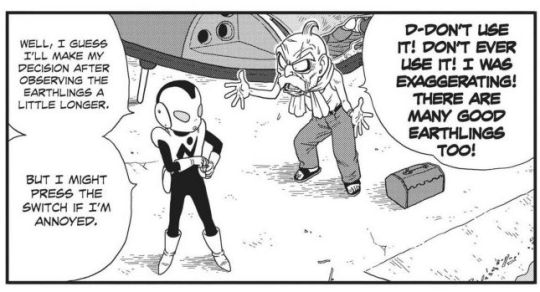
Fortunately, Jaco has a device which will eradicate all intelligent life from the planet. When activated, it will release a deadly virus. I like how Omori’s bitterness turns to dread here. It was easy for him to complain about the world around him, because he never dreamed he would meet someone capable of destroying it without a second thought.
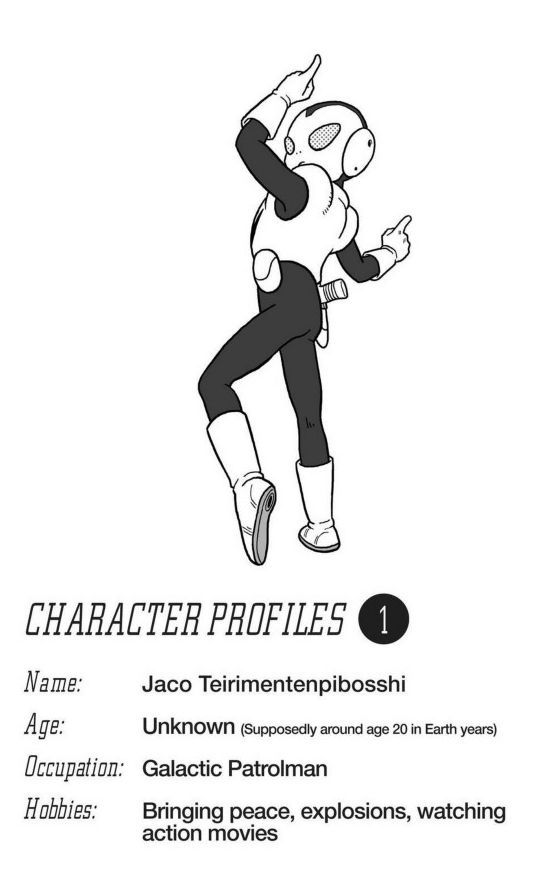
Each chapter ends with a character profile. I won’t show them all, but I’m mostly interested in this one because it has Jaco’s full name.

Chapter 2. Omori takes a look at Jaco’s ship, and they continue to talk. He’s surprised by Jaco’s strength, considering his small size, and Jaco defensively says he’s the third tallest of the 38 Galactic Patrollers. How can they maintain peace in the galaxy with only 38 Patrollers? Jaco says there aren’t a lot of planets with intelligent life.
Then a ship arrives on the island. Jaco spot it from very far away, and he moves out of sight when its passengers disembark to speak with Omori, but he still hears their entire conversation, because Jaco has super-hearing too.
Basically, they’re from the government, and they want Omori to leave the island, so they can turn it into a resort or something. Omori is just squatting here, so he has no legal claim to the place. He pleads with them to reconsider, reminding him that his wife’s grave is here, but they won’t listen. Jaco waits for the ship to leave before coming out of hiding. He extends his sympathies...
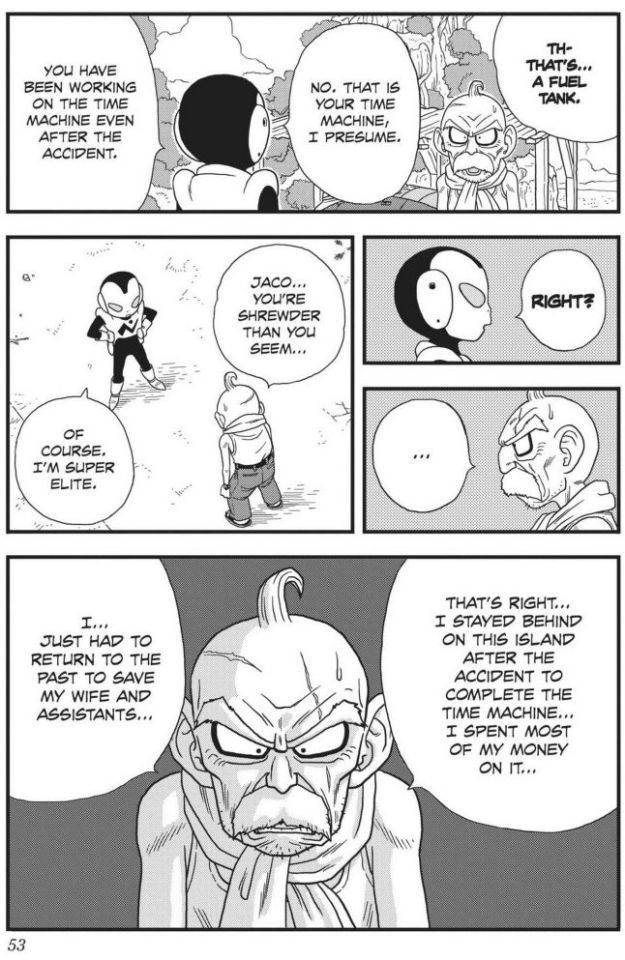
But he also tells Omori that he spotted an experimental time machine in a secluded spot on the island. Omori admits that he’s been working on it ever since the accident. His goal is to use the machine to save his wife and assistants from the accident that killed them. But he says it doesn’t work. The best it can do is slow the passage of time to a near-standstill, and it only works for one person. Jaco decides he can let that slide.
He also throws a rock at the departing ship, and the chapter ends with the people on board using a life raft, since Jaco’s throw was powerful enough to sink the ship.

Chapter 3. Jaco continues to insist that he is a Super Elite, because the Galactic Patrol is a small organization under the direct supervision of the Galactic King. Jaco was one of nine people to apply for a spot on the team, and he was also one of the five people chosen. Omori isn’t very impressed.
I guess that sums up the flavor of humor with Jaco. He’s got all these super powers and advanced technology, and Omori is sort of impressed, but not as much as you would expect. Jaco’s got all the resources of an advanced civilization, but he still flew his ship into the moon and he blew off the lesson on spaceship repair. It’s impossible to tell if the Galactic Patrol should be taken seriously or not.

Omori has now studied Jaco’s ship long enough that he thinks he understands the general principle of its operation, and it all depends upon this unknown substance in the engine. A laser is supposed to hit it, which produces enough power to fly the ship, but it was damaged in the crash, and it will have to be replaced. So Omori first has to identify the material and then find out if there’s any of it on Earth. So while Jaco waits, he watches more media coverage of the upcoming Twinkle 8 launch. This feels kind of important, although it’s unclear how this could possibly matter to anything.
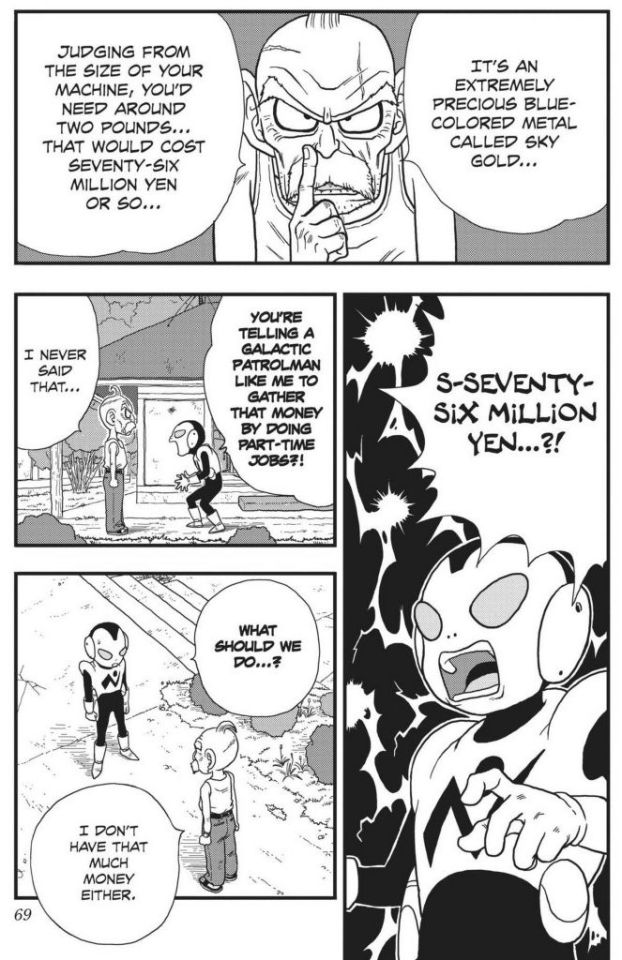
Finally, Omori discovers that the unknown material in Jaco’s ship is available on Earth. The problem is that it’s called “Sky Gold,” a precious metal that costs 76 million yen for the amount needed to resupply Jaco’s ship.
I like how Jaco’s first reaction to this news is that he’ll have to do part-time jobs to earn the money, like that’s going to be the setup for the true premise of this comic. I mean, it could have been. I could see that being a hit. But Omori’s like “What the hell are you talking about?”
Anyway, the good news is that Jaco only needs about 19 million yen’s worth of Sky Gold to make it back to his headquarters. Oh, right, I should point out that his communications systems were also damaged in the crash, so he can’t send out a distress signal.
Chapter 4. Jaco and Omori don’t know what to do about the Sky Gold problem, but in the meantime, Omori needs to sail to the mainland to buy more food. Jaco can only eat milk and cheese, and he just drank the last of the milk, so he’ll need more. Jaco expresses an interest in the city, so Omori reluctantly agrees to bring him along.

The problem is that Jaco keeps making a spectacle of himself whenever he sees a crime in the city.
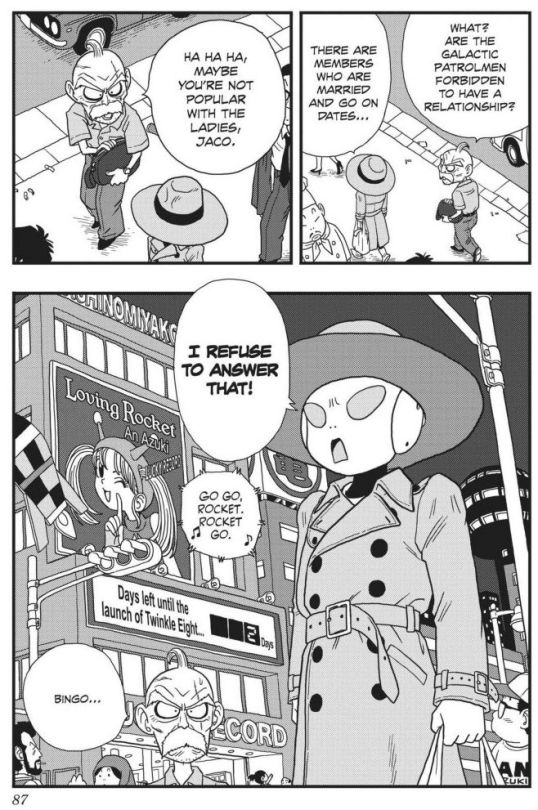
Omori buys some peanuts and Jaco remarks that in his culture, “peanut” is a word they use for a woman’s left buttock. Omori is intrigued that Jaco’s species has women, and asks if Jaco has a love interest. Jaco does not, because he’s a colossal dork.
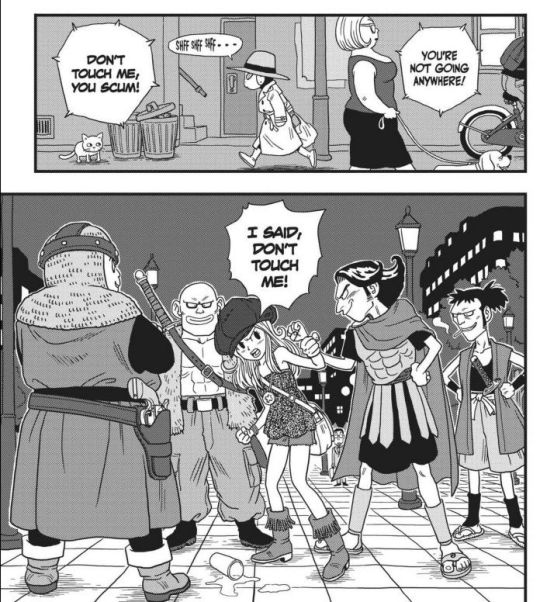
Chapter 5: While Omori is buying dairy products for Jaco, Jaco wanders off and notices another crime in progress. This time he sees a bunch of jerks pushing around a teenage girl. I don’t know if they’re a gang or what, but I like the whole theme of them being dressed up like different soldiers. The one guy’s got Roman soldier gear, and there’s a Medieval knight with a gun and some sort of samurai, I guess.
A lot of folks in East City are dressed in weird costumes like this. It seems to be part of the local culture, and I guess that might explain why Tights looks like some sort of hippie.

So Jaco sees this happening and he leaps to the rescue.
Seriously, I just really dig all these costumes. See, this is what sets Toriyama apart from all the wannabes. You or I could go “Uhhh, how about a Super Saiyan 5! Or maybe Frieza and Cooler fuse and become Coolza!” Meanwhile, Toriyama actually comes up with genuinely new ideas.

I mean, the action in this story is pretty similar to that of his other works, but it’s a completely fresh direction. Jaco is super-strong like Arale and Goku, but he’s an alien who needs to keep a low profile, and his commitment to justice overrides his better judgement.
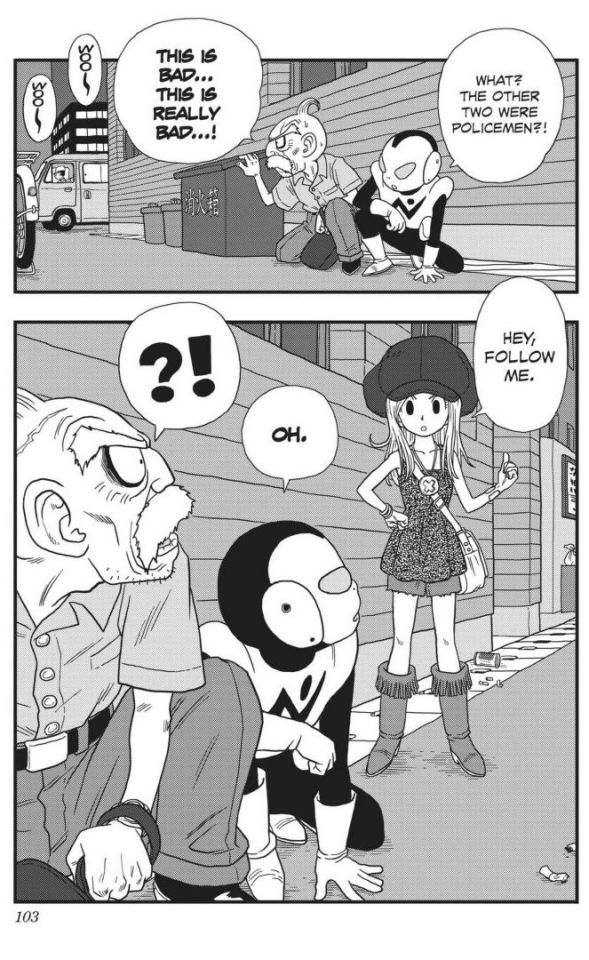
So now Omori is horrified, because this time Jaco’s attracted more attention than they can possibly avoid, and they have to hide from the authorities. But just as they worry about what to do next, Tights offers to help...
So this is off to a promising start. The stakes are a lot lower than what we see in Dragon Ball, but it’s nice to read a smaller, slower story. The first three chapters are kind of dull, but a nice, relaxing dull that you don’t mind at all.
So far, Professor Omori is what makes this for me. I like his bitter attitude, and how he uses it to mask his obvious grief. And I think I’d like Tights too, but we really haven’t gotten to know her yet, so I’ll reserve judgement until next time.
#jaco the galactic patrolman#2023dbapocryphaliveblog#jaco teirimentenpibosshi#tokunoshin omori#tights#an azuki
15 notes
·
View notes
Text
Akira Toriyama ‘Sand Land’ Manga Is Getting Video Game Adaptation

Akira Toriyama is now working with Bandai Namco on an adaptation of Sand Land Akira Toriyama’s imaginative storytelling and dynamic art style have captivated audiences worldwide. The creator is also known for putting his penchant for character design to good use in the Dragon Quest video game series. However, fans were surprised when one of Toriyama’s lesser-known manga, Sand Land, was announced to receive a video game adaptation at Summer Game Fest. Originally serialized in Weekly Shonen Jump from May to August 2000, Sand Land is a one-volume manga set in a post-apocalyptic desert world. The story revolves around Beelzebub, a mischievous demon prince, and Sheriff Rao, a stalwart elderly man. Together, they embark on a perilous journey to locate and secure a much-needed water source for their arid land, which has suffered from severe drought. Coming from Bandai Namco, the game adaptation promises to faithfully recreate the manga’s setting, allowing players to take control of Beelzebub and traverse the barren wastelands while encountering various unique and quirky characters. From desert bandits to eccentric creatures, the world of Sand Land will be brought to life with Toriyama’s signature art style and distinct character designs. Sand Land is headed to PS5, Xbox Series X/S, and PC, but no word yet on the release date.

Read the full article
6 notes
·
View notes